If you’re planning on spending 2 days in Barcelona, perhaps over a weekend, then we’ve put together this itinerary to help you plan your perfect visit.
Barcelona is a city that Jess and I have visited many times. There is so much to see and do, certainly more than would fit into two days. However, with careful planning, you can definitely see a lot of the city and many of the highlights in a couple of days.
If you have more or less time, check out our guide to spending a day in Barcelona, as well as our 3 day Barcelona itinerary.
In this guide, we’re going to share with you our idea of how to spend two days in Barcelona. This focuses on the highlights that a first-time visitor is likely to want to see, but it also includes a few of our favorite sights that aren’t so popular.
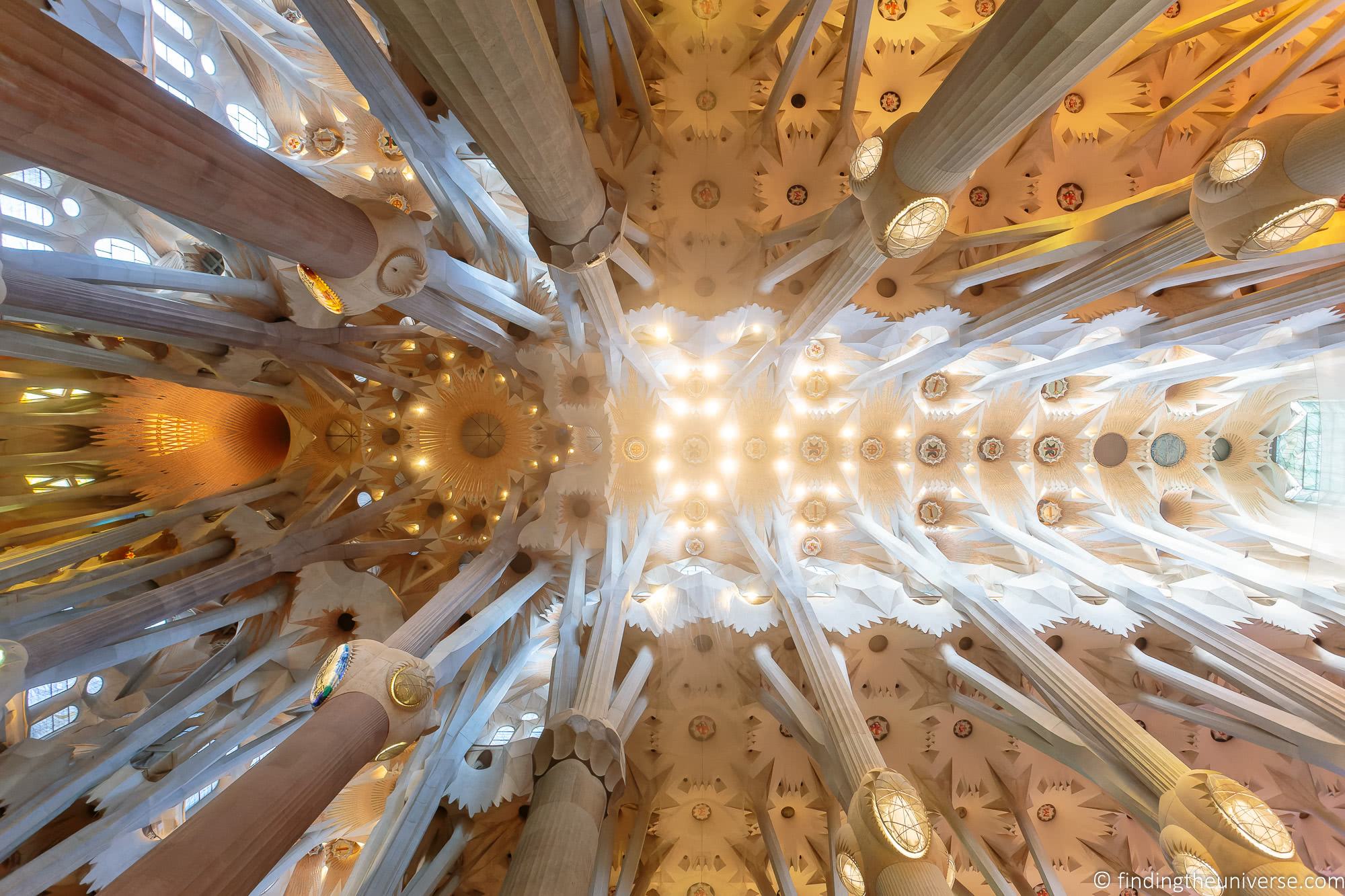
As well as the itinerary, we’re going to tell you everything you need to know to plan your time in Barcelona. From where to stay, to how to get around, to how to save money on attractions, this guide has you covered. Let’s start with the itinerary itself.
2 Day Barcelona Itinerary
As with all our itineraries, this one should be taken as a starting point for you to plan your own time in the city. We think it makes for a good two days, but we appreciate that everyone has different interests. So you can personalize it as needed.
Additionally, we like to pack a lot in when we travel, so if you prefer to see less, or are visiting Barcelona as a family with children, do tweak it to meet your own travel style.
Finally, you also want to check the opening times and dates for each attraction as some are closed one day per week or might have annual closing periods. So make sure they are open before you set out.
Barcelona Itinerary Day 1
Today you’re going to see one of the world’s most famous cathedrals, as well as a number of other sights around the city! Let’s get started.
Hop on Hop off Bus
Today, I’m going to recommend you get around using the Hop on Hop off bus. A few of today’s attractions are spaced a little apart, and Barcelona’s Hop on Hop off bus is an easy way to get between them. It’s also a great way to learn about the city as you go, thanks to the included audioguide.
Of course, you could get between today’s sights by public transport or other forms of transport, as covered in the section on getting around Barcelona. But as many of the city passes for Barcelona include at least a day of hop on hop off bus travel, it is worth taking advantage of.
There are a couple of sightseeing bus services in Barcelona. We recommend the Barcelona Bus Turistic which is operated by the city’s tourism office. For this itinerary, we’re specifically recommending you take the Blue route.
This starts in Placa de Catalunya, and visits all the attractions on today’s itinerary. Buses run at least every 20 – 30 minutes, you can get on and off as many times as you like, and service normally starts at 9am.
You can book your tickets online in advance here. Also included on the Go Barcelona pass and Barcelona City Pass.
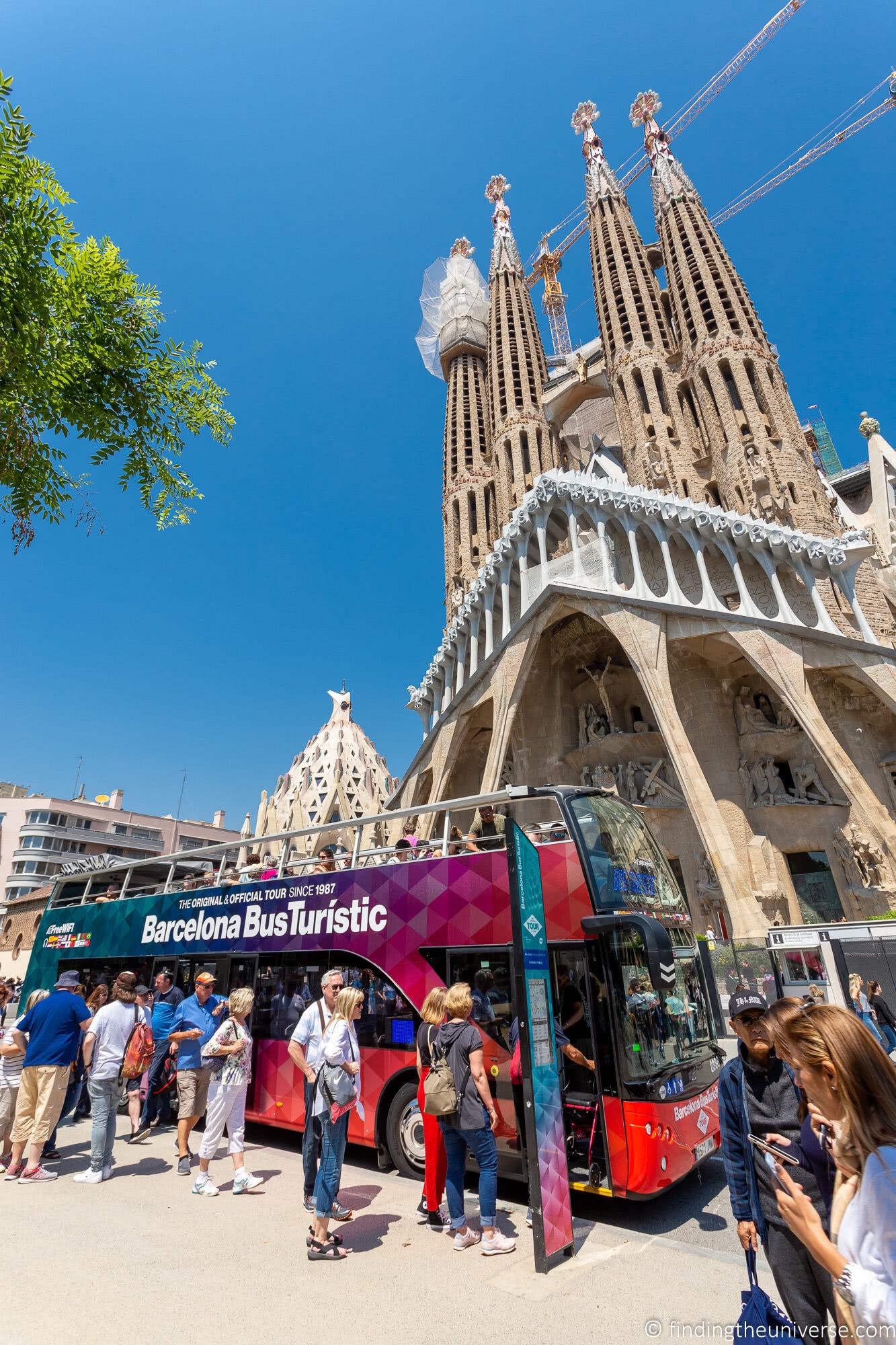
Sagrada Familia
Your first attraction stop today is going to be at the incredible Sagrada Familia cathedral. In our opinion this is a must-see sight in the city. We recommend coming here earlier in the day, and it is one of the first stops on the Hop on Hop off bus route.
Whilst there is currently timed entry, there is no limit to how long people can stay, so it can get busier as the day progresses.
The Sagrada Familia is without doubt the most famous and impressive structure from the mind of architect Anton Gaudi. He was responsible for a great many works in the city (see our guide to Gaudi in Barcelona for many more), but the Sagrada Familia is by far the largest and most well-known.
If you were to only visit one Gaudi structure in Barcelona, we’d recommend making it the Sagrada Familia.
There is plenty to see here, and as the building is still under construction, what you can see changes on each visit. Highlights for us include the incredible “forest” of pillars holding the nave up, as well as the huge exterior façades. However, there is more than enough to see here to last for at least a couple of hours.
See our complete guide to visiting the Sagrada Familia, which has everything you need to know to plan a visit.
You need to book your entry to the Sagrada Familia in advance. You can do so on the official website here. Third party sites also offer tickets and tours, including GetYourGuide, Tiqets and Viator. These can be a good option if the official site has limited availability, or if you’d prefer to take a guided tour.
Finally, the Sagrada Familia is included on some of the city’s attraction passes. You’ll want to check exactly what the pass includes, as some include a guided tour at a specific time, whilst others just provide entry.
Currently, the Sagrada Familia is included on the Go Barcelona Pass, Barcelona City Pass and Gaudi Bundle.
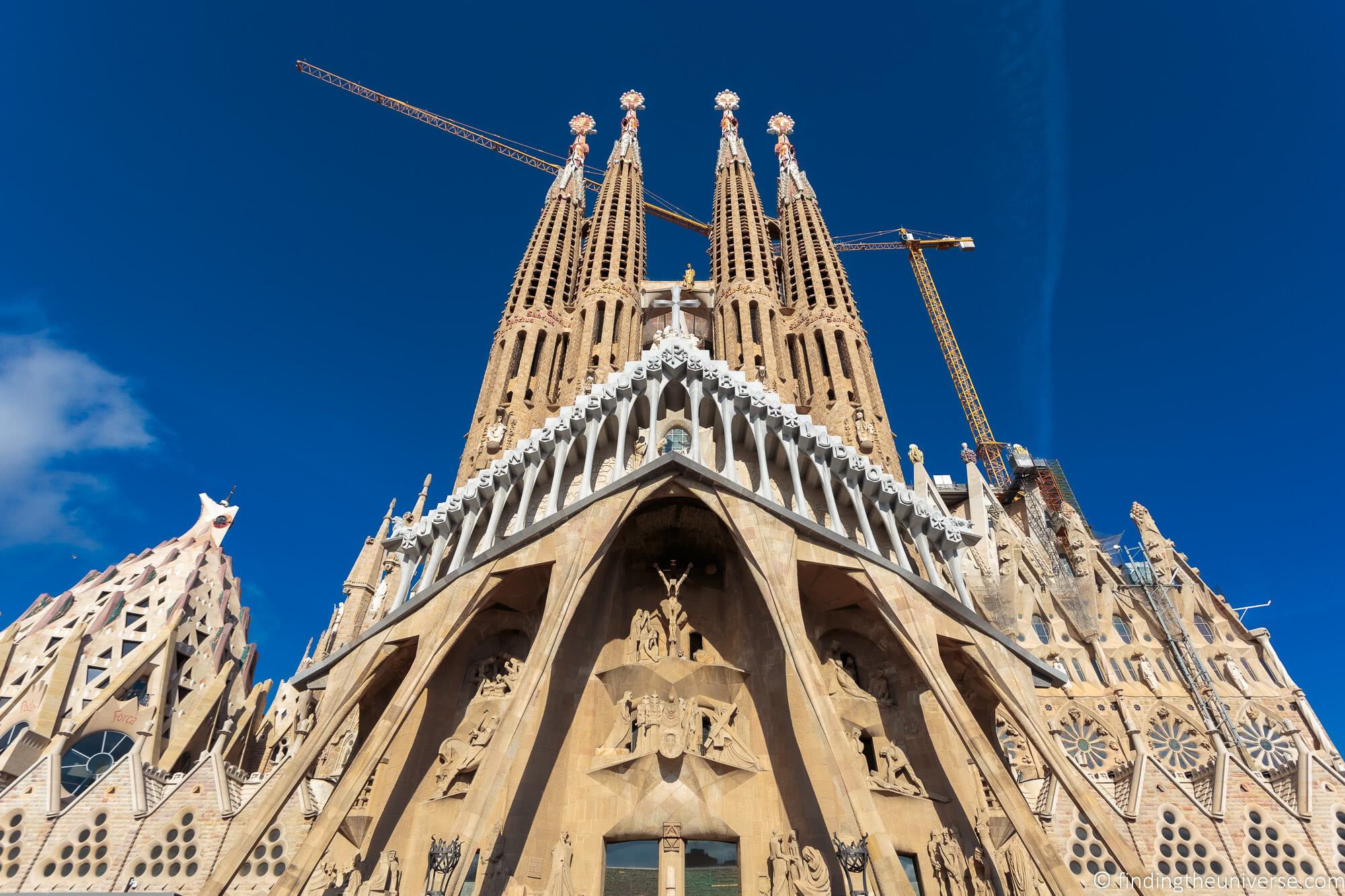
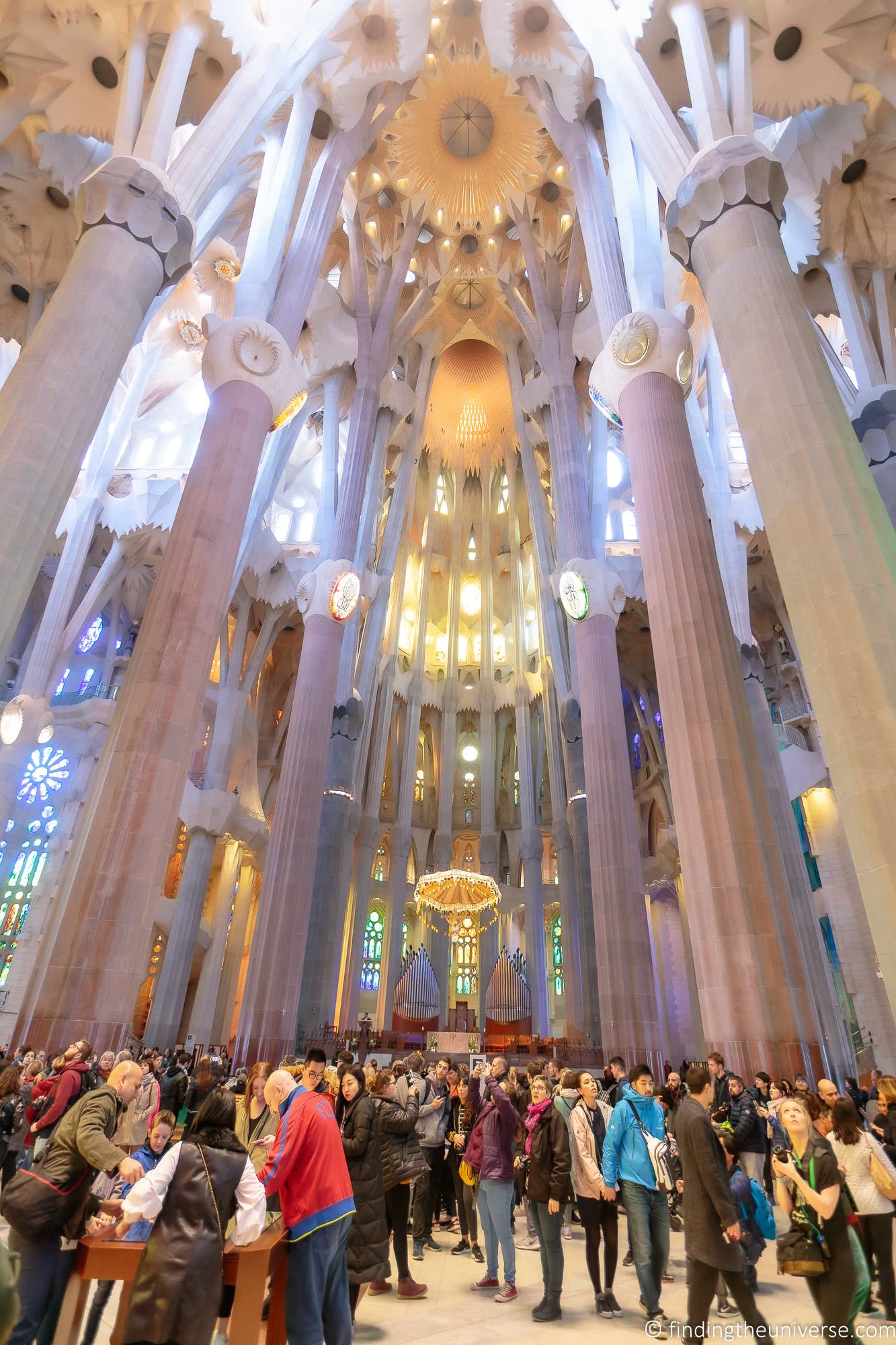
Sant Pau Recinte Modernista
After the Sagrada Familia, our next recommended stop (and also the next stop on the hop on hop off bus blue route), is the Sant Pau Recinte Moderniste. Alternatively, it’s around a 20-minute walk between the two locations if you prefer to stretch your legs.
This complex was originally built as a garden city for the sick. It was built between 1905 and 1930 in the art nouveau style, and designed by architect Lluís Domènech i Montaner.
Today, the location is a UNESCO world heritage site, and is home to one of the most impressive collections of art nouveau buildings in Europe.
We love wandering this location, it feels very different to the organic structures employed by Gaudi, and as it’s less popular, it also makes a nice break from the crowds of Gaudi’s attractions.
There’s a fee to visit, and it’s included on the Go Barcelona Pass. You can also book tickets online in advance here.
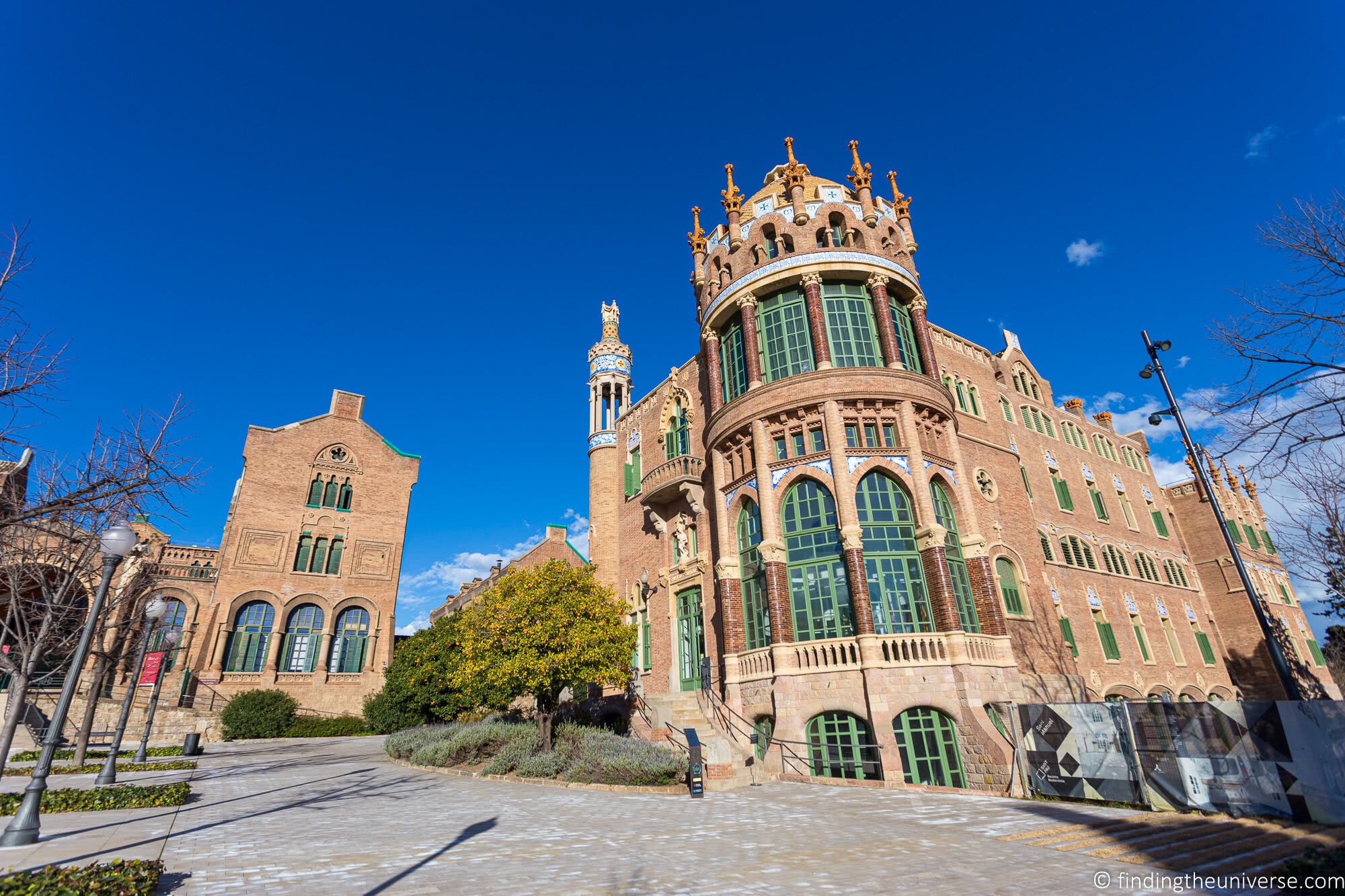
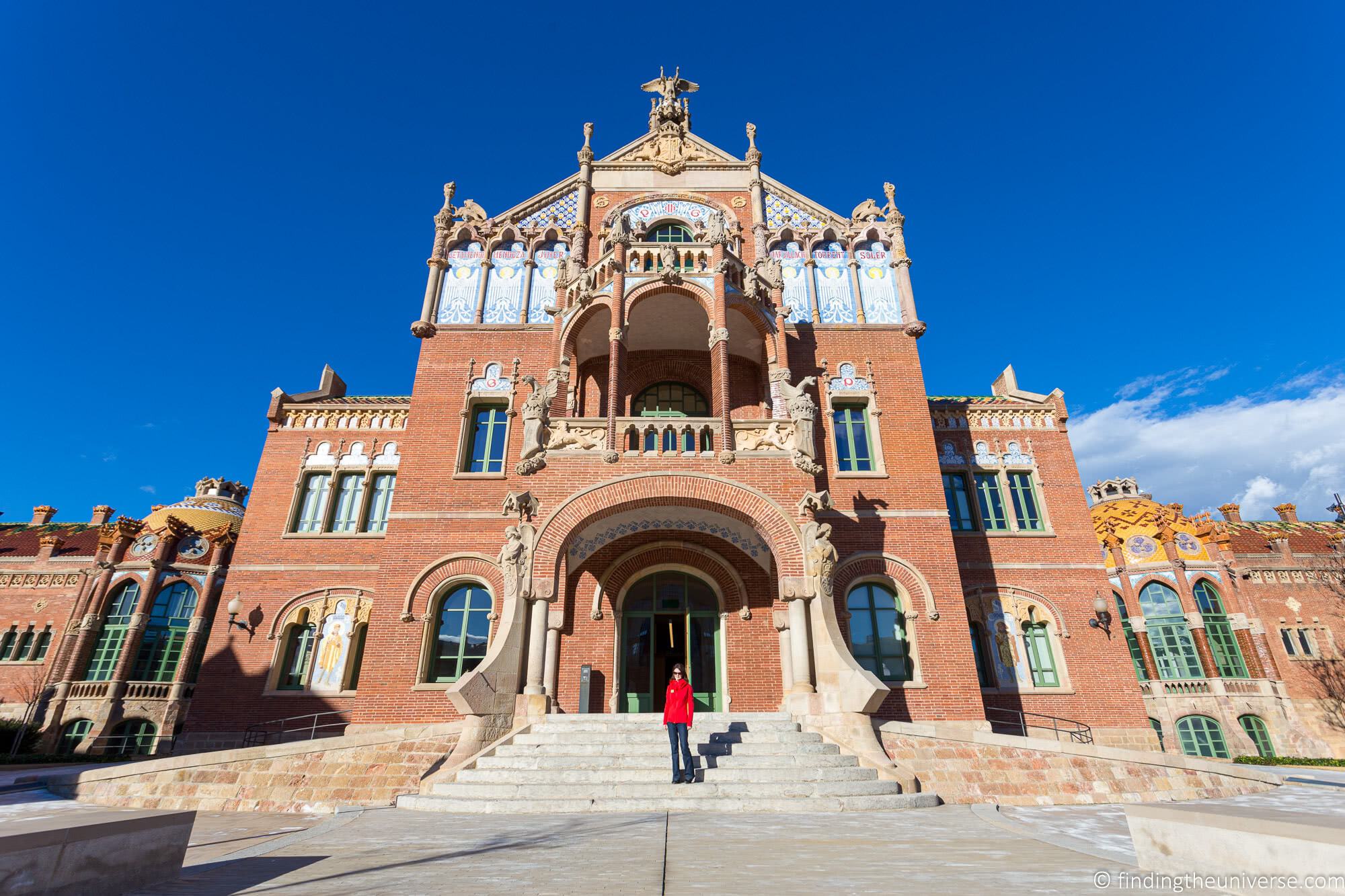
Park Guell
Your next stop on your first day exploring Barcelona is Park Guell. This is one of the next stops on the Hop on Hop off bus, a 20-minute ride by public transport from Sant Pau, or a 30-minute walk.
Park Guell is another of Gaudi’s works in the city. It was originally conceived as a housing development which would offer residents clean air and good views. The setting is a large park.
Unfortunately, the vision was never fully realised. Two of the houses were built, although they were not actually designed by Gaudi. Instead, the architect was responsible for the park design. He also lived in one of the show homes on the site for 20 years, from 1906 to 1926. This is now open to the public as the Gaudi House Museum.
Most visitors to Park Guell come to explore the Park, and it’s so-called Monumental Zone. This part of the park has a fee to enter, and is where you will find highlights like the terrace and mosaic installations. It is a very impressive place to visit and well worth spending at least an hour exploring.
Whilst much of Parc Guell is free to visit, the main attractions of the Monumental Zone do have a fee.
Currently, Parc Guell is included on the Go Barcelona Pass, Barcelona City Pass and Gaudi Bundle.
You can also book tickets for Parc Guell on the official site here and GetYourGuide here. There is also a combined ticket which includes the Gaudi House Museum and Parc Guell here.
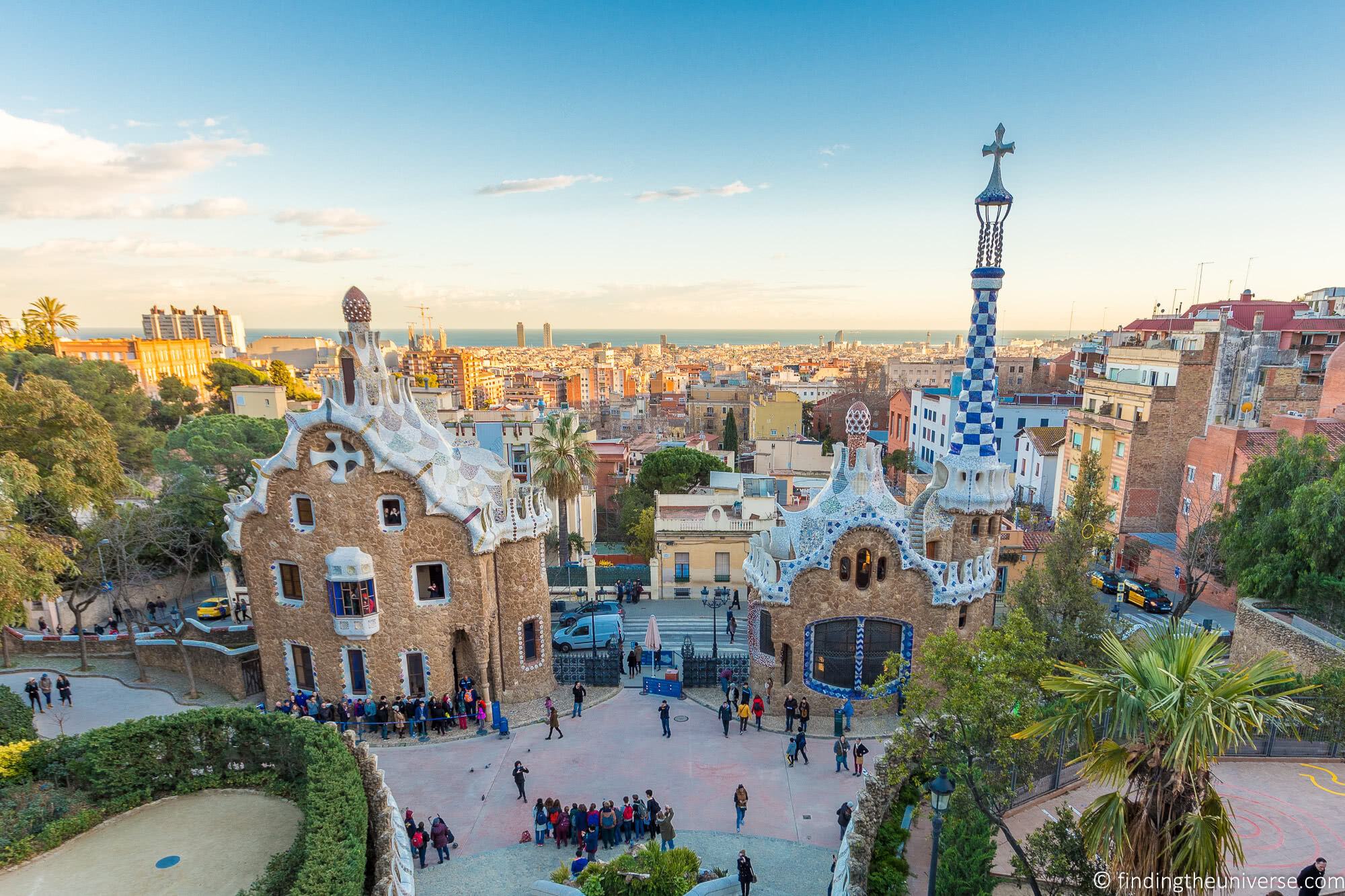
Camp Nou or Tibidabo
Your final stop for your first day in Barcelona will depend on your interests. The hop on hop off bus route continues around Barcelona, with the option to visit both of these locations.
Option 1: Camp Nou
Camp Nou has been the home of FC Barcelona since 1957. FC Barcelona are one of Europe’s most well-known and successful football (soccer for those of you in the USA) clubs. They are also one of the most supported clubs in the world, with fans hailing from every corner of the globe.
As such, many visitors to Barcelona have an interest in visiting Camp Nou, to see where their favorite players play. You can of course try to see an actual match, but if that’s not possible, you can take a behind the scenes tour of the stadium.
Now, I’ll be honest, neither Jess nor I have a great interest in football. However, we have visited the Camp Nou stadium and we both enjoyed it. The tour was interesting, it was fun to see behind the scenes, and we got a real sense of the history of the team and the passion the fans have.
Of course, if you are an FC Barcelona fan, or have a general interest in football, then you will probably enjoy it even more.
A visit to Camp Nou includes a visit to the FC Barcelona Museum, as well as locations like the stand, the pitch, the away team changing room, tunnel and pressroom. There are also additional, more premium experiences available that grant further access.
Camp Nou is included on the Go Barcelona Pass. You can also buy individual tickets here.
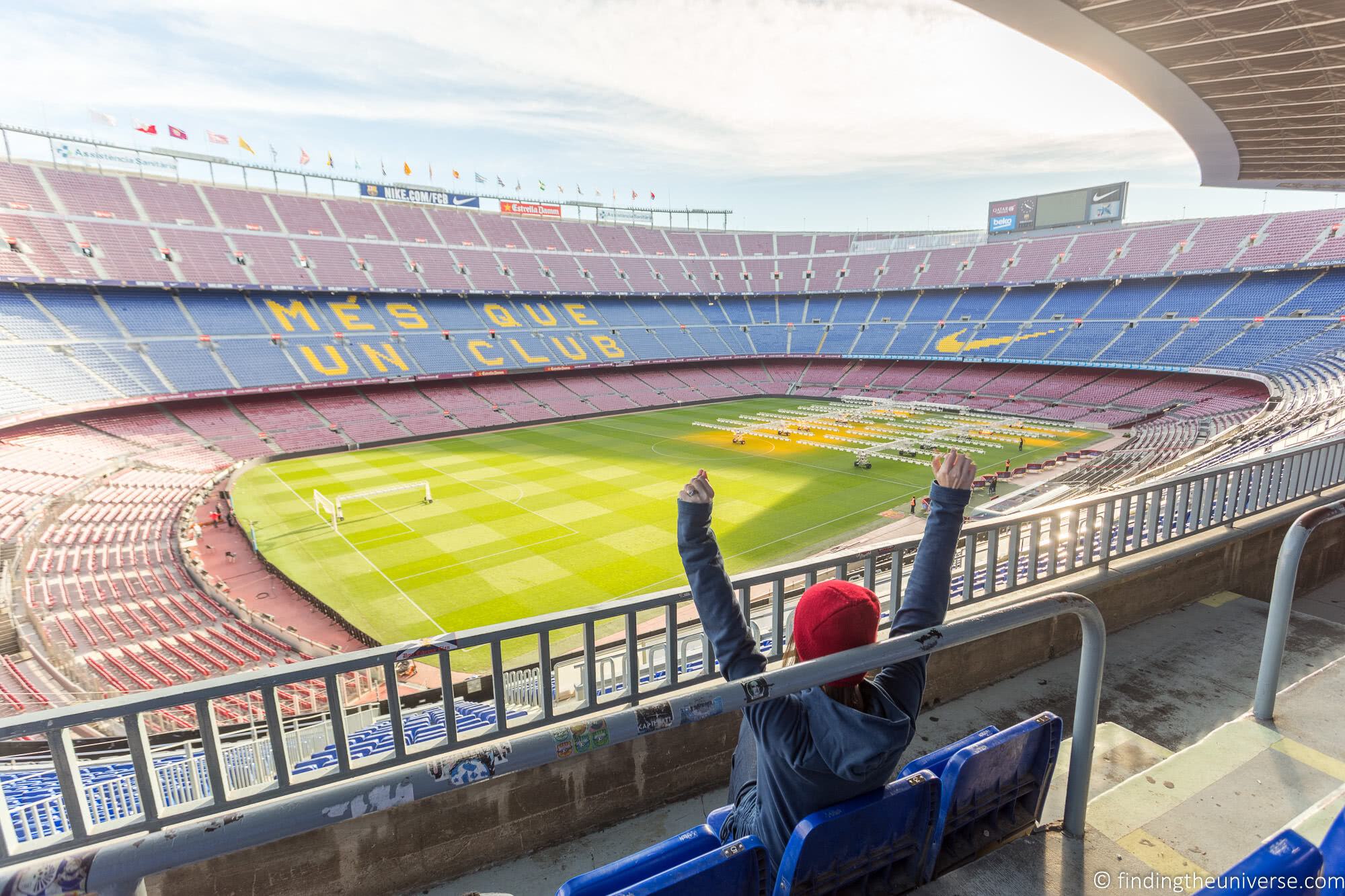
Option 2: Tibidabo
If you aren’t so excited about a visit to a football stadium, or would just like an alternative option to consider, then we suggest instead considering a trip up Tibidabo.
Tibidabo is a hill to the north-west of the city, which offers spectacular views across the city and surrounds. The top of the hill is crowned by the impressive Sagrat Cor church, and there is also an amusement park here called Tibidabo Amusement Park.
The park offers a small number of rides, including a simulated airplane ride which dates from 1928 as well as a large Ferris wheel. Woody Allen fans will recognise the park from the movie Vicky Cristina Barcelona, part of which was shot here.
The easiest way to reach the Tibidabo summit is by the Tibidabo Funicular. Conveniently, the hop on hop off bus has a stop at the station. There’s a fee to ride the funicular, and you can get tickets on site. The Tibidabo Amusement Park also has a fee, which gives you access to all the rides. You can save by buying tickets online in advance here.
I would add that I still think it’s worth going to the top of the Tibidabo for the views and to visit the church, even if you don’t visit the amusement park.
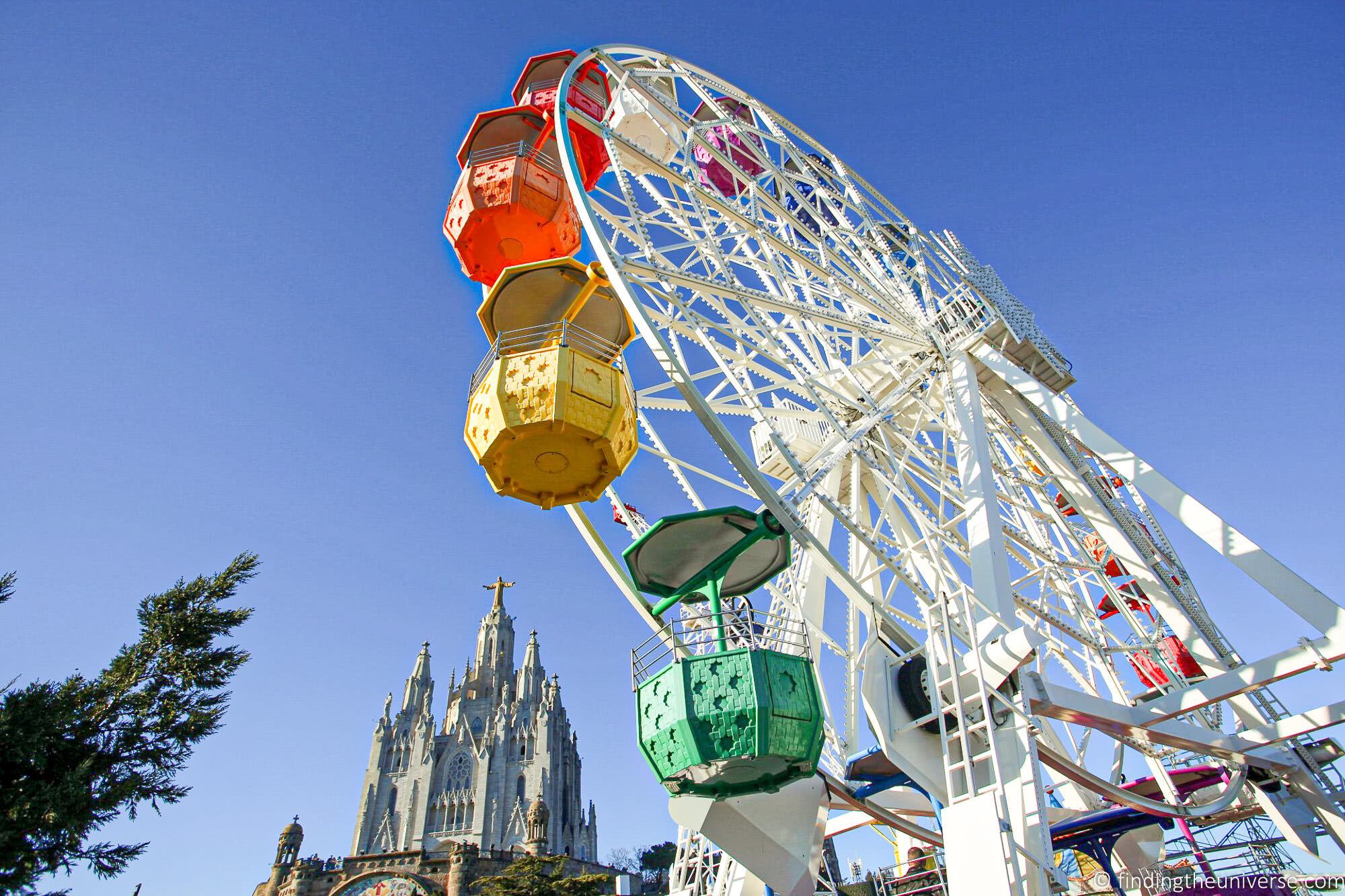
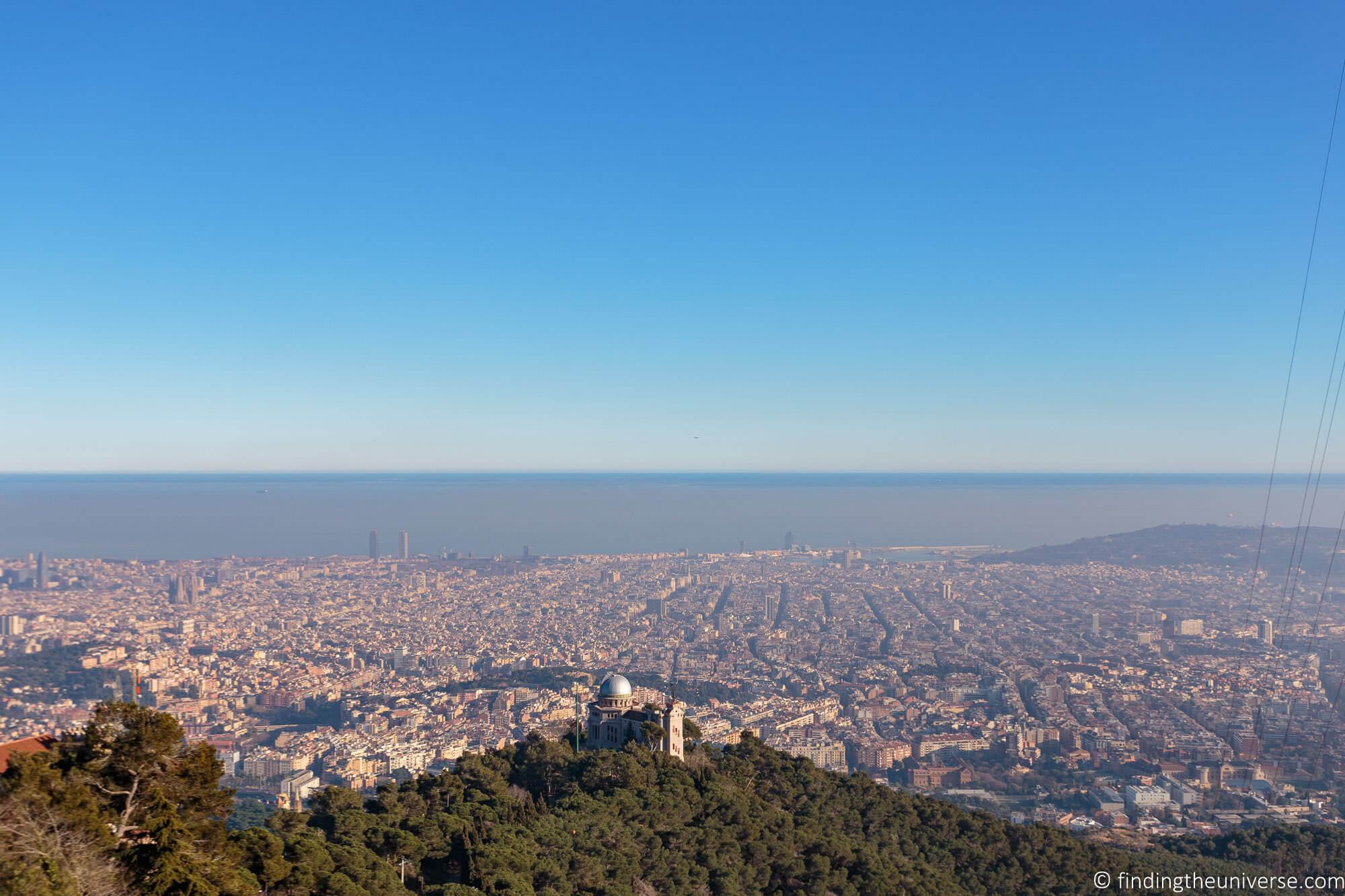
That brings us to the end of your first day exploring Barcelona, at least in terms of sight-seeing. Now you can head back to the city, relax, or head out for dinner and fun.
If you are looking for something fun to do in the evening, you might consider a dinner show with entertainment. Flamenco shows (sometimes with an accompanying meal or tapas) are a popular option for visitors to the city. For example, check out this show with optional dinner and drinks, or this show only option.
Barcelona Itinerary Day 2
Your second day in Barcelona has you exploring some of the city centre attractions. Let’s get started.
Casa Batlló
Whilst the Sagrada Familia is spectacular in both design and scale, it’s obviously not a structure that is designed for living in. So if you want to get an idea of the sort of house that Gaudi built for actually dwelling in, then you will want to visit one (or both) of the two properties at the start of this itinerary.
First, the Casa Batlló. This is found in the city’s Eixample district, just a few minutes’ walk from Placa Catalunya.
This house was actually a remodel of an existing house, completed by Gaudi in 1904. It’s famous for the balconies which look like opera masks, the dragon-like rooftop, and the flowing organic feel of the interior.
Today the house forms a part of the Gaudi UNESCO world heritage site and is a very popular tourist attraction. As such, we recommend starting your day here so as to avoid the worst of the crowds which tend to build up as the day progresses.
Entry to Casa Batlló is included on the Go Barcelona Pass. You can also buy individual tickets here. It is definitely one of the pricier attractions in Barcelona, so if you do include it on your itinerary an attraction pass is highly likely to save you money overall.
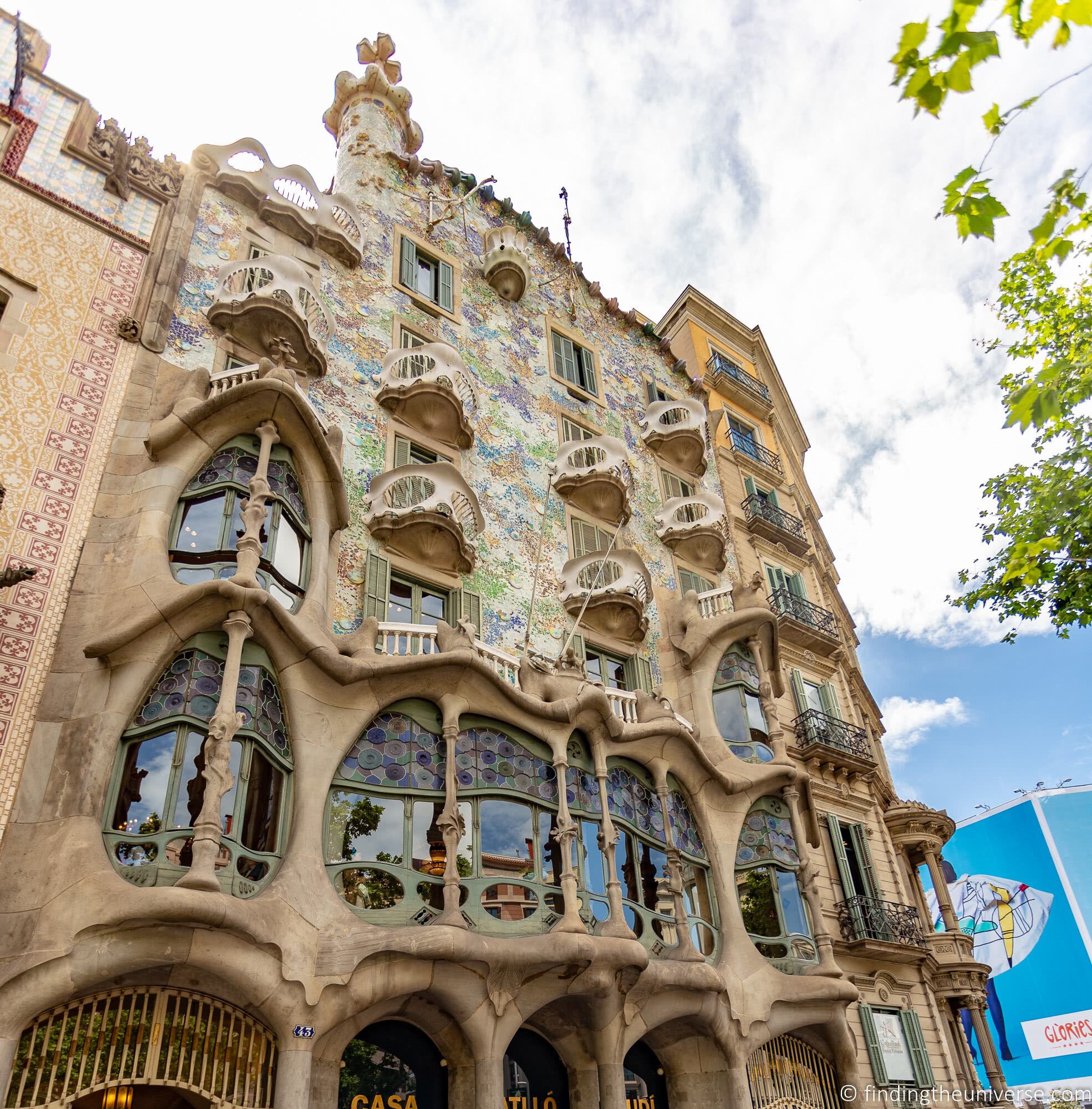
La Pedrera
A couple of blocks from Casa Batlló is Casa Mila, which is more commonly known as La Pedrera, or “The Quarry”. This is another Gaudi property, famous for the organic concrete facade that wraps around the building.
Unlike Casa Batlló, this apartment building still has residents, so a visit here only grants you access to certain areas. These include the vaulted roof space where there is a good museum about Gaudi and his work, as well as the stunning chimney-dotted roof which offers nice views over the city and across to the Sagrada Familia.
There is an entry fee to La Pedrera, and it is also included on the Go Barcelona Pass. Alternatively, you can buy tickets online here.
If you aren’t planning on investing in the Go Barcelona Pass, we’d probably recommend visitors to Barcelona pick either Casa Batlló or Casa Mila to save money. You may also need to save time if you have a lot of activities booked later in the day. Both of them have unusual exteriors that are interesting to see even if you don’t visit them.
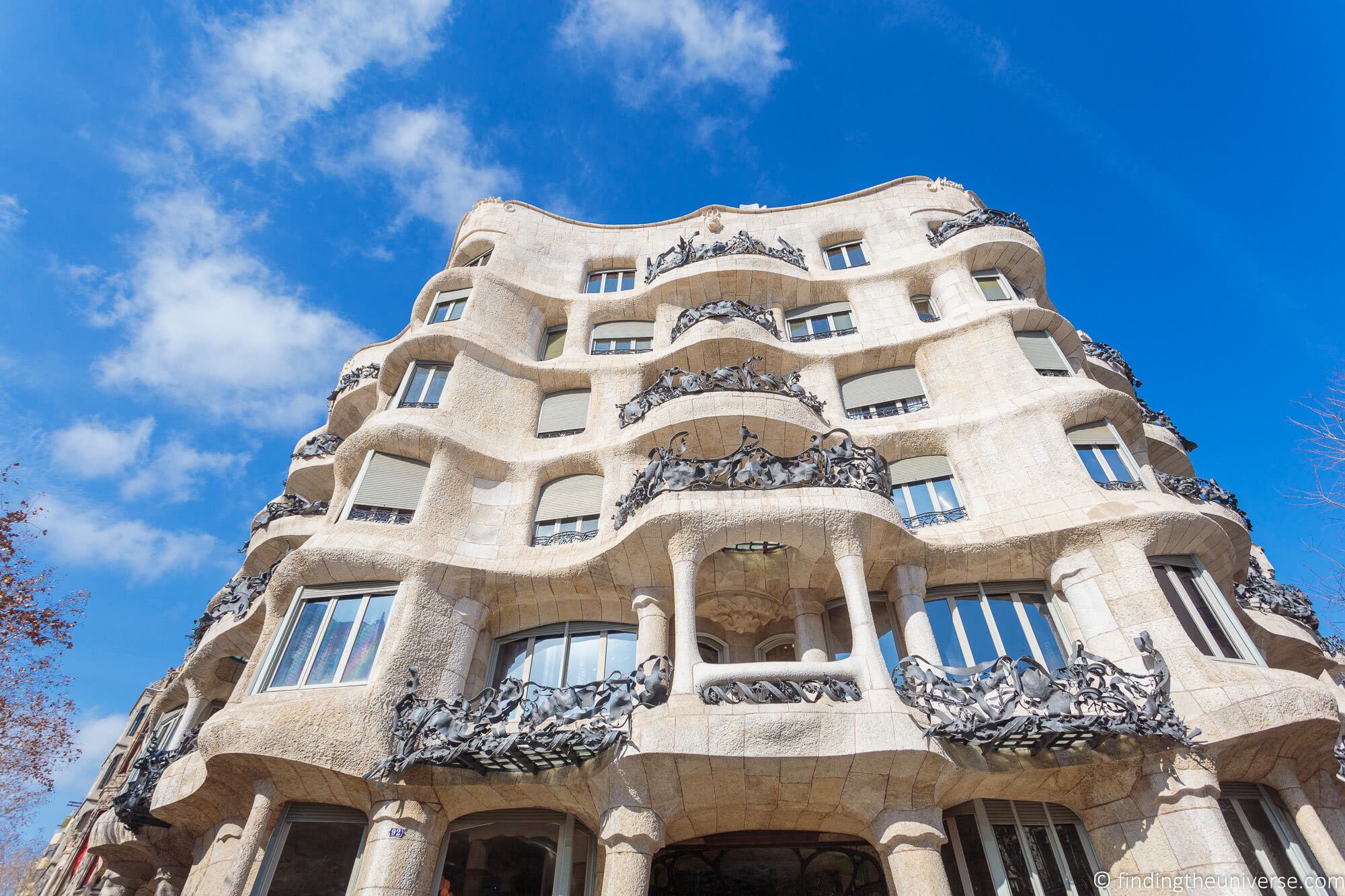
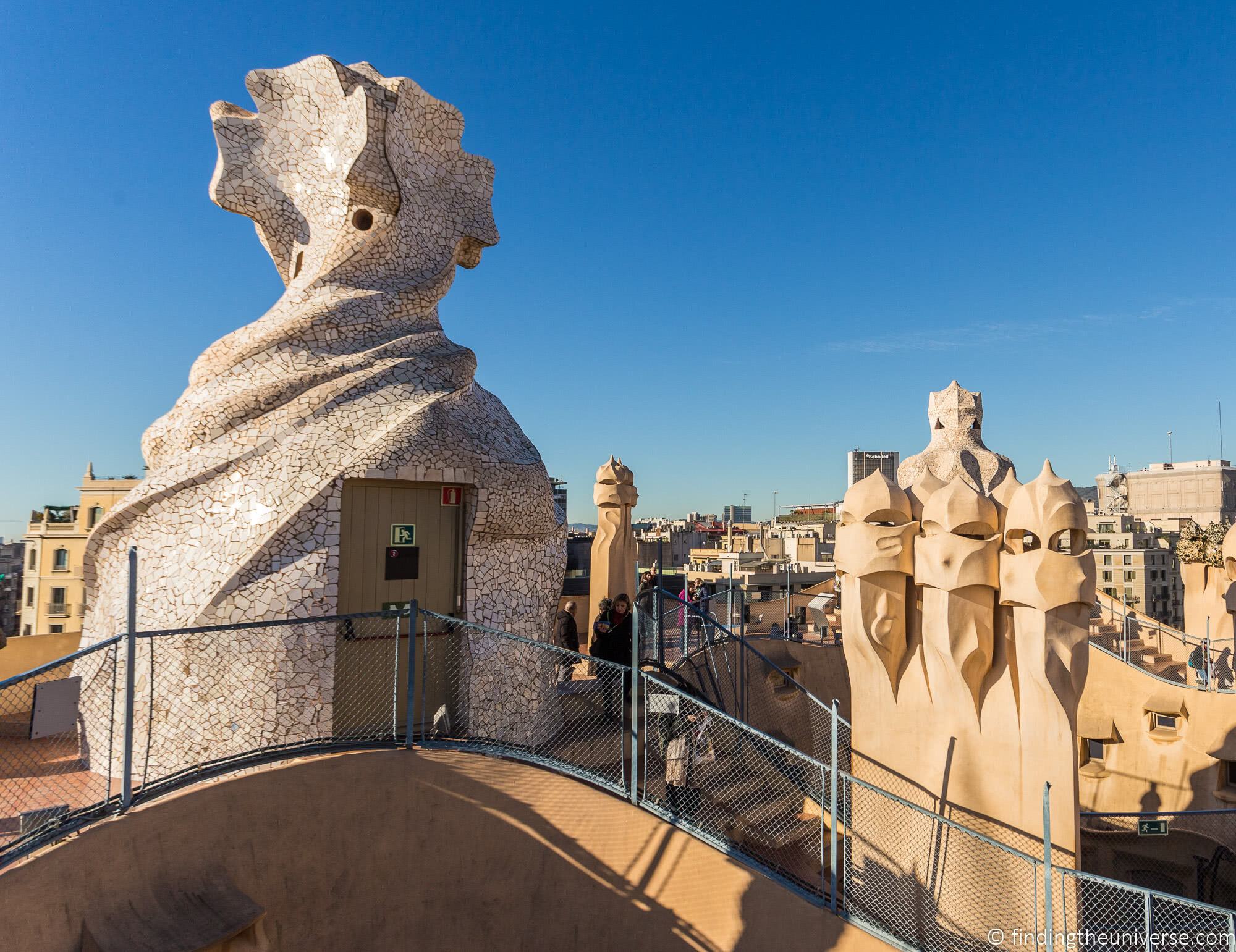
La Rambla / Gothic Quarter Walking Tour
One of our favourite parts of Barcelona to wander around is the Gothic Quarter. This is in the oldest part of Barcelona, which was founded by the Romans in 15BC. The Gothic Quarter is bordered by the sea to the south east, and the famous La Rambla street to the south west.
Las Rambla was originally a stream on the border of the Roman city wall which encircled the city. Today it is a popular place to take a stroll, have a drink or snack, and do some people watching. It’s also home to La Boqueria, one of the city’s most well-known public markets.
The Gothic Quarter is still very much medieval in feeling. Unlike the wide avenues and symmetrical layout of other parts of the city, the Gothic Quarter features narrow streets with looming buildings on either side. It’s largely pedestrianised, great to wander around, and quite easy to get lost in.
We recommend taking a walking tour of the area if you want to learn more about its fascinating history. We have a list of recommended walking tours further on in our itinerary, but a couple we recommend that include the Gothic Quarter are:
If you plan on taking a tour, you might have to adjust this itinerary to take into account the start time of the tour. I’d also add that you can of course visit the Gothic Quarter on your own and just wander around without a tour should you prefer. Both are great ways to explore.
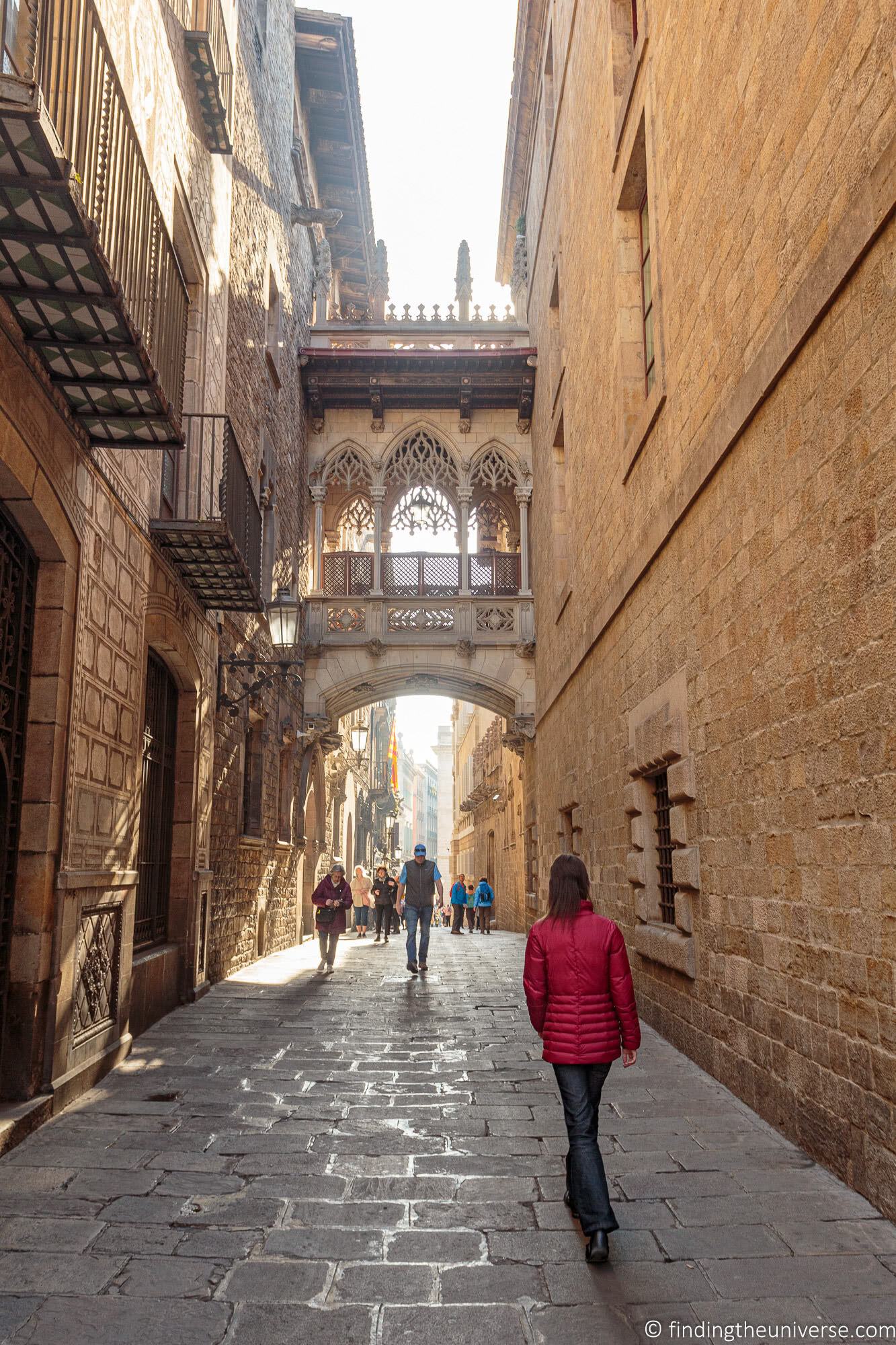
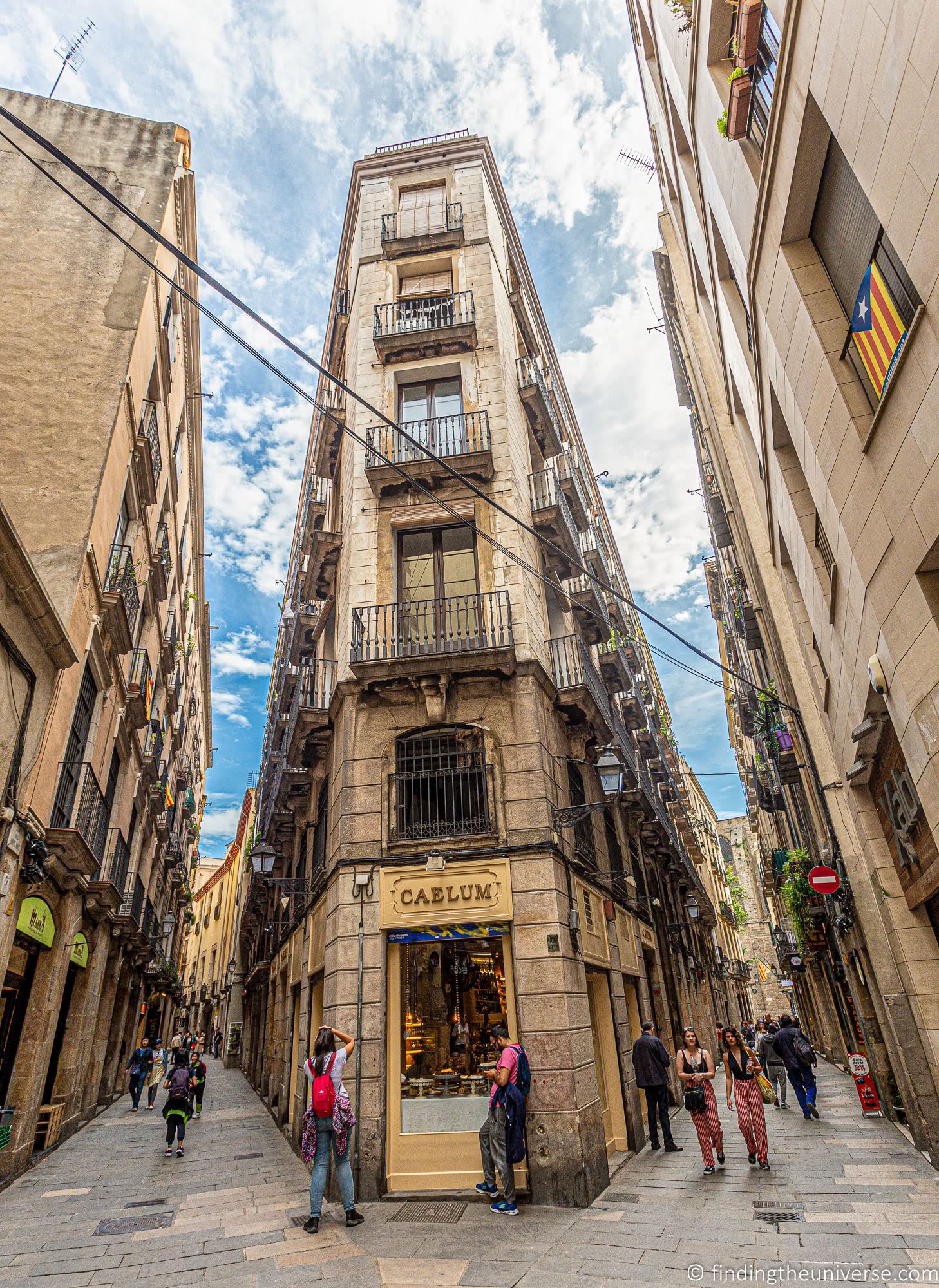
Santa Maria Del Pi
One of my favourite spots in Barcelona which isn’t normally too busy is this church in the Gothic Quarter. The Church of Saint Maria of the Pine is a 15th century Gothic church, with a peaceful interior. It often plays host to concerts and performances.
The reason I like it though is the gigantic octagonal bell tower. This tower is almost 200 feet (60 metres) high, and you can go to the top for fantastic views over the Gothic Quarter. It is a truly impressive construction, with walls almost 12ft (3.5 metres) thick at the base.
Visiting the church itself is free, but there’s a fee to climb to the top. The fee is well worth paying in my opinion as it includes a guided tour, and when I took the tour the guide gave a lot of information about the history of the city and its layout.
Check the website for opening times and prices. You can also buy tickets online in advance through the official site.
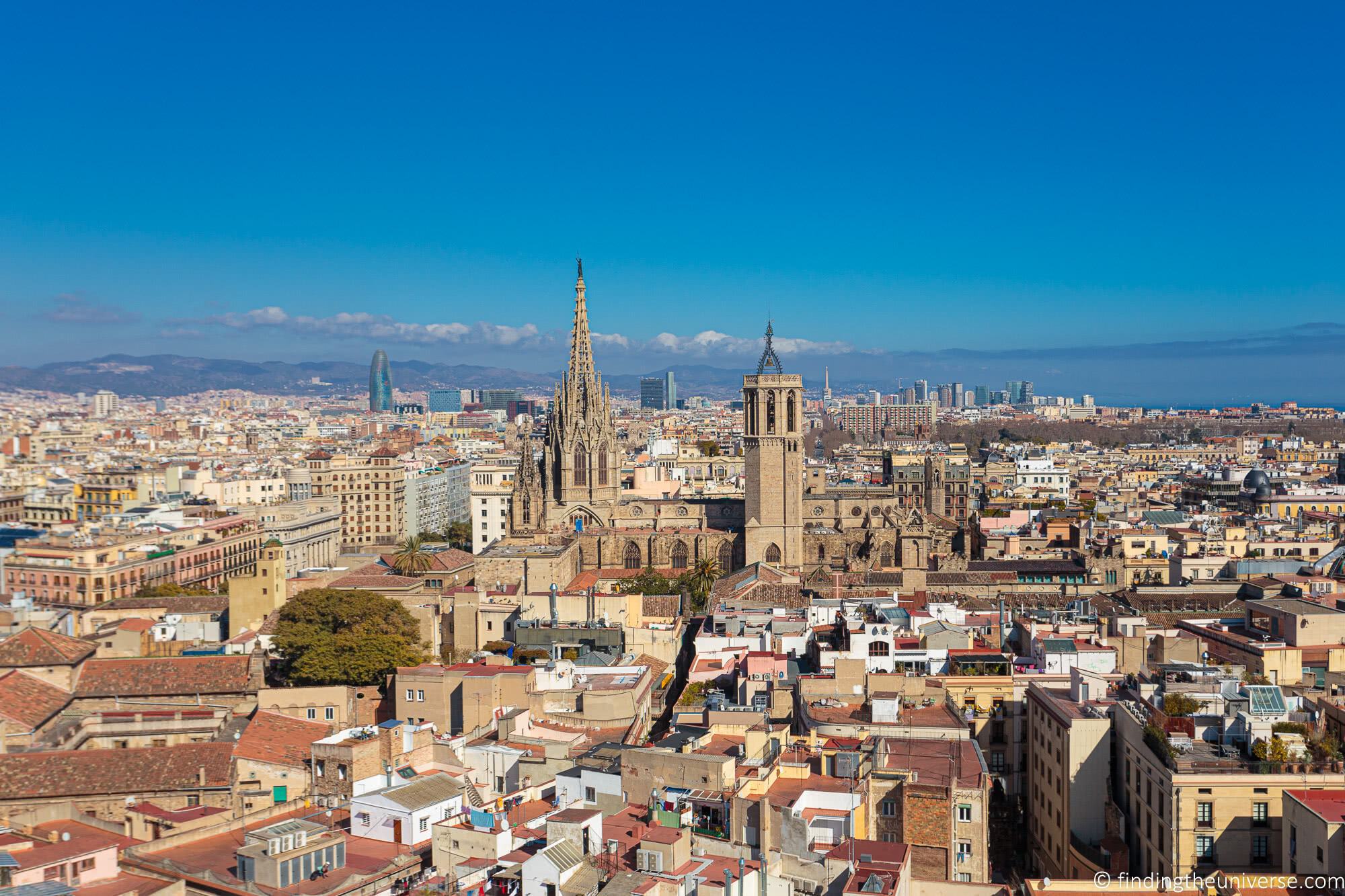
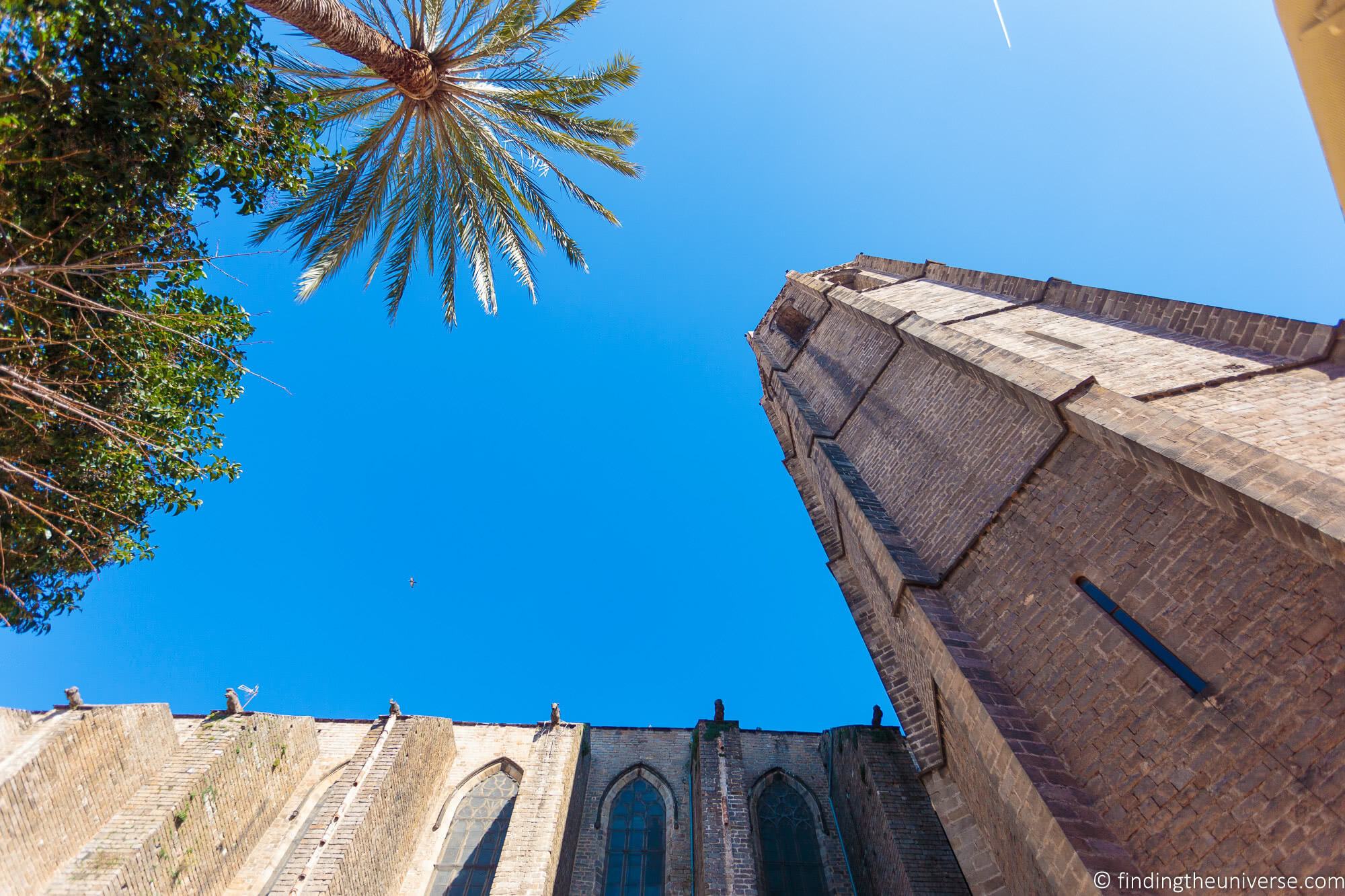
Montjuic and Magic Fountain
To end your day of sightseeing, you’re going to head up Montjuic Hill. This hill is found just to the southwest of the city centre, near to the port.
There is a lot to see at the top of Montjuic hill, from the 17th century Montjuic Castle through to the Joan Miro foundation, Poble Espanyol open air museum, National Art Museum of Catalonia, tiered gardens, Barcelona Olympic village and more. There are also excellent sweeping views across the city.
If you are interested in visiting a good museum in Barcelona, then we can definitely recommend the National Art Museum of Catalonia (Museu Nacional d’Art de Catalunya). It has a large collection of both art and historical objects. Just note that if you do plan a visit here, you’ll need to skip or shorten visits to some of the suggested places above to ensure you have enough time for an afternoon visit. It’s located about a 5 minute walk from the fountains.
You could walk to the top, but we think a better option is to take the Montjuic Funicular followed by the scenic Montjuic cable car which runs from Estaciò Funicular on Avenida Miramar up to the Castell de Montjuic.
The Funicular is part of the metro service, and departs from Paral·lel station. The Montjuic cable car is ticketed separately but is included on the Go Barcelona Pass. You can also buy tickets in advance here.
One thing we definitely recommend planning for the end of your day is to try and take in the Magic Fountain display. This is a free sound, light and water display which happens most evenings.
The fountain is found below the Palau Nacional at the head of Avinguda Maria Cristina. It’s a lovely way to end a day in the city in our opinion. You can see the timetable of the show here.
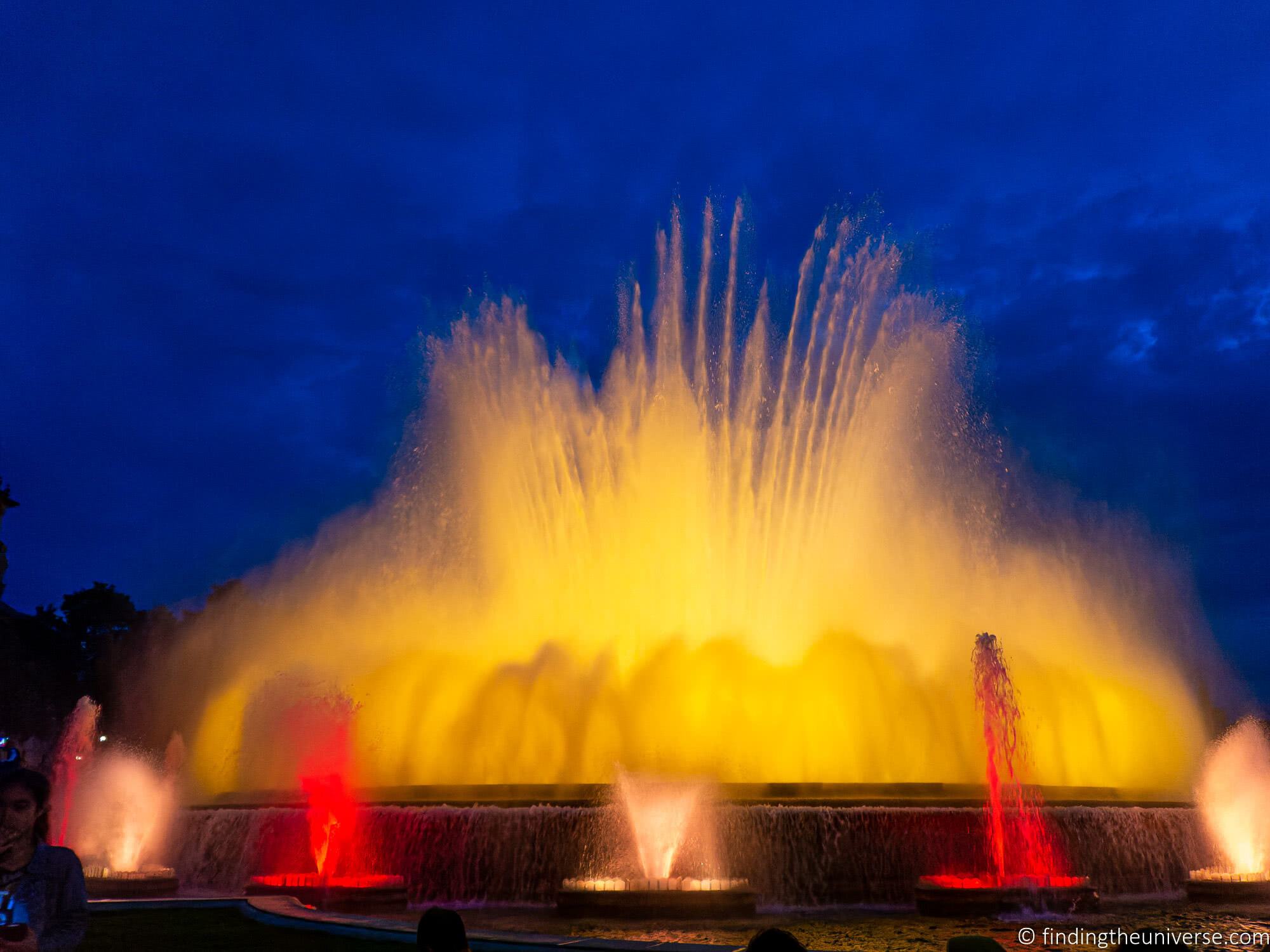
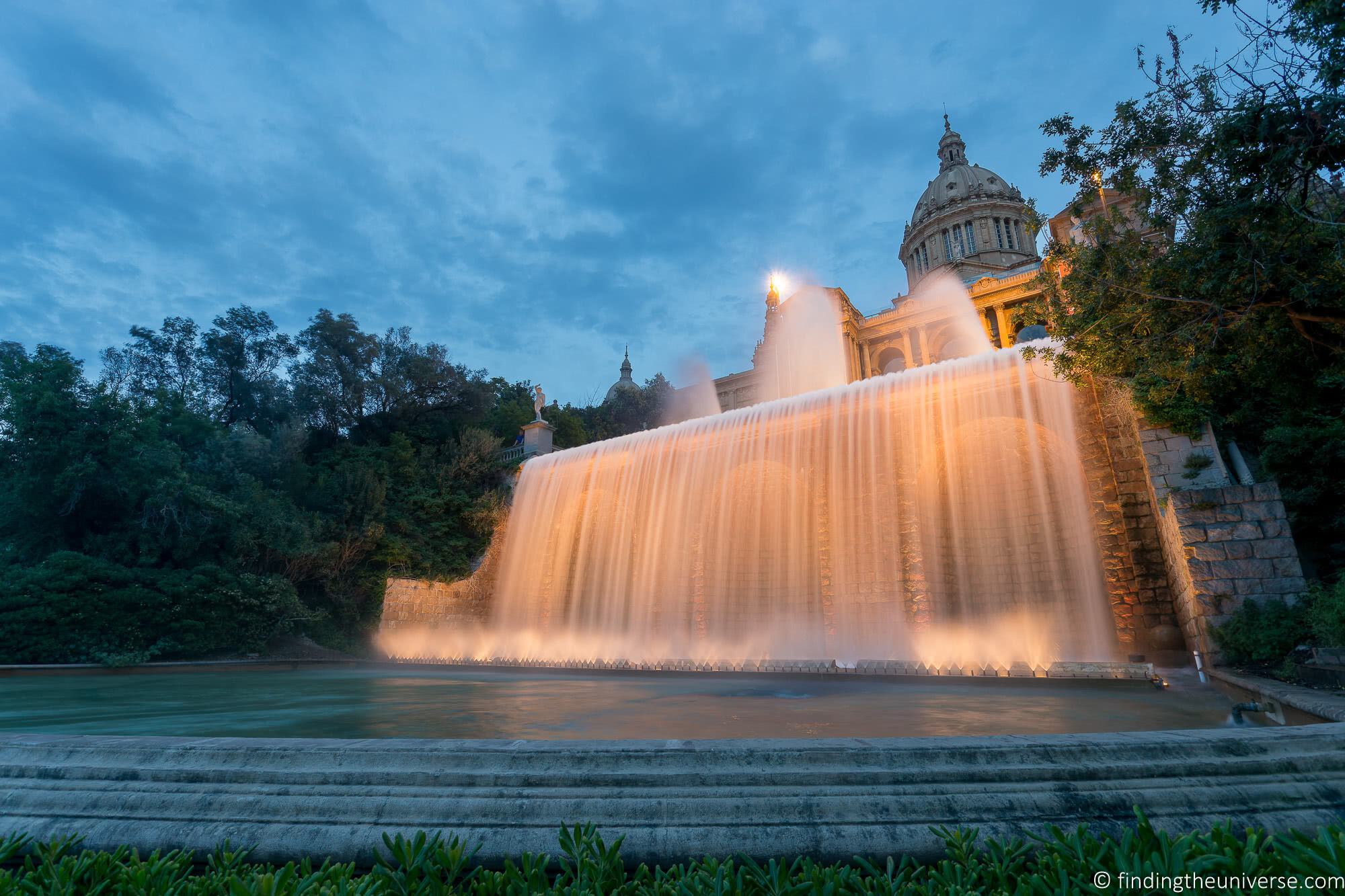
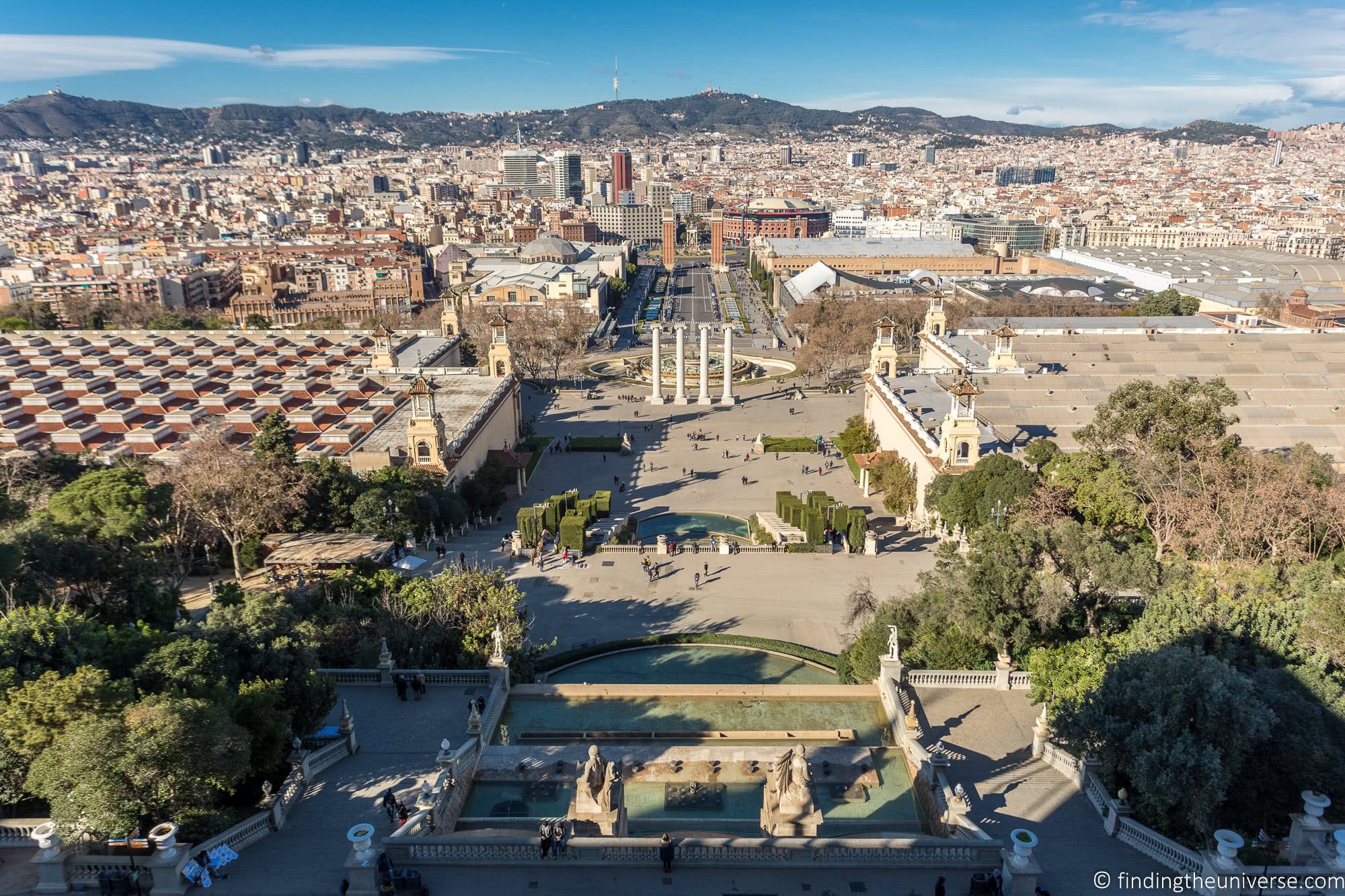
That finishes up the itinerary section of this guide. We’ll now cover lots of practical information to help you plan the perfect trip to Barcelona.
2 Day Barcelona Itinerary Summary
Here’s a quick summary of this 2-day Barcelona itinerary for reference.
- Barcelona Itinerary Day 1 – Hop on Hop off Bus, Sagrada Familia, Sant Pau Recinte Modernista, Park Guell, Camp Nou or Tibidabo
- Barcelona Itinerary Day 2 – Casa Batlló, La Pedrera, La Rambla / Gothic Quarter Walking Tour, Santa Maria Del Pi, Montjuic and Magic Fountain
Map of Barcelona Things to Do
For ease of visualisation, here is a guide to the attractions on the itinerary. We’ve also included some recommended hotels so you can see where they are in relation to the city’s attractions. You can also see this map on Google Maps here.
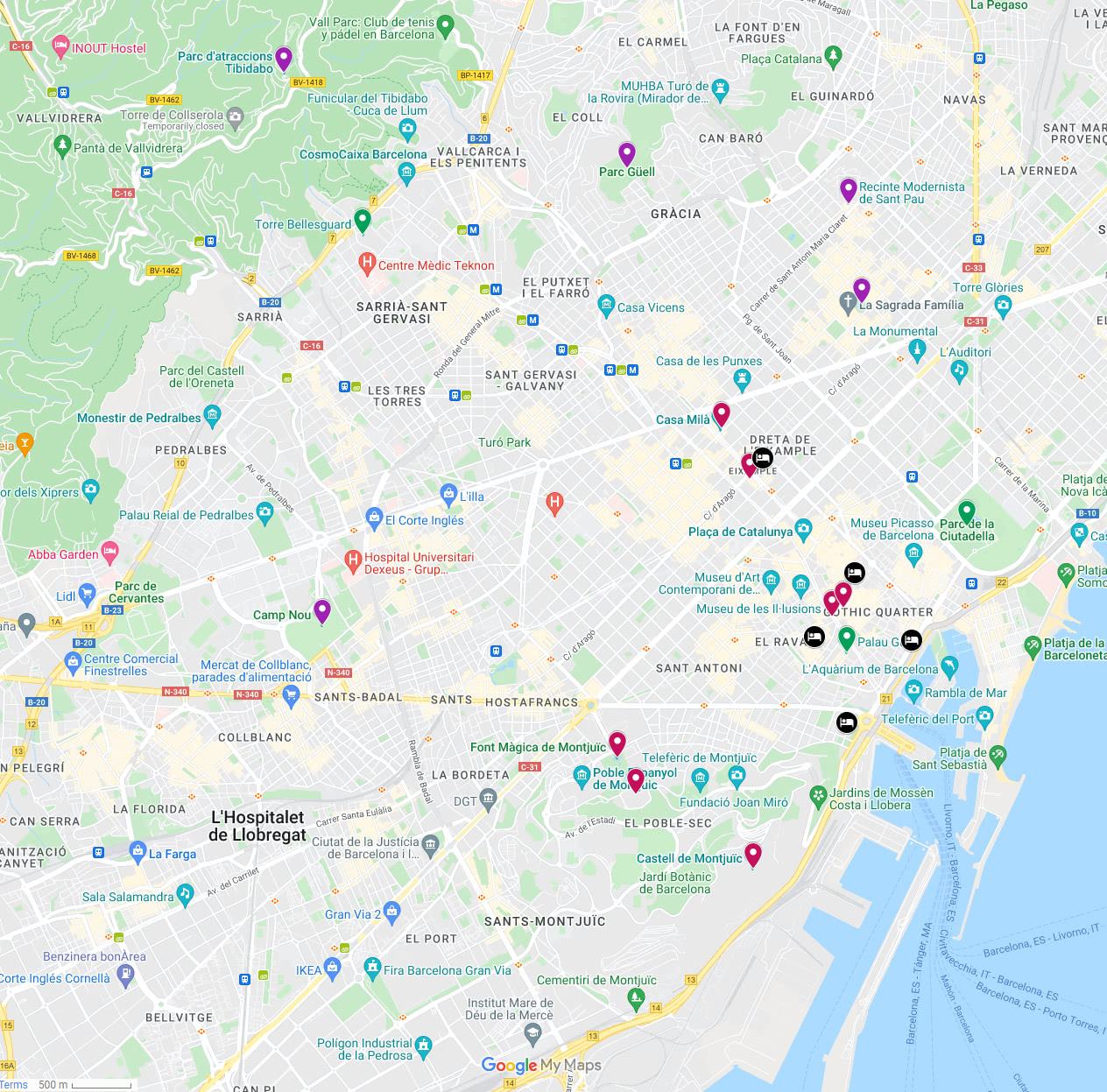
Where to Stay in Barcelona
Barcelona has a huge amount of choice when it comes to accommodation, and we’ve stayed at a number of different locations in the city in both apartments and hotels.
Our preferred option when booking accommodation is booking.com (see their Barcelona listings here). They list everything from hotels to apartments to hostels, and we find they usually have the widest range at the most competitive prices.
To give you an idea of what’s available, here are some options we recommend:
- Hostel One Ramblas – a very well reviewed and very central hostel option
- The 8 Boutique B&B – a highly rated and well located bed and breakfast
- Hotel Barcelona Catedral – a 4* property in Barcelona in the heart of the Gothic Quarter. We’ve stayed here, and enjoyed the roof top pool and incredible central location.
- Leonardo Hotel Barcelona Las Ramblas – part of the good value Leonardo chain, this 3* property is a few moments from Las Ramblas. We enjoyed our stay here, and the breakfast in particular was excellent.
- Duquesa de Cardona – a 4* property on the waterfront with a roof top bar
Apartment rentals through sites like Plum Guide, Airbnb, and Vrbo are also available. One thing to be aware of is that in Barcelona these need to be registered with the city. When they are registered, they will be issued a license number. If you want to stay in an apartment rental in Barcelona, then we recommend picking one which has the license number on the listing.
If you would prefer to stay in an apartment in Barcelona, then we recommend Plum Guide. We’ve stayed at a number of their properties around the world, and you can see our review of the Plum Guide here. See their listings for Barcelona here. We also recommend Vrbo, see their Barcelona listings here.
If you can’t find what you want from the above choices, or you want some new options to try out, we wrote a whole post on the best alternatives to AirBnB which you should check out!
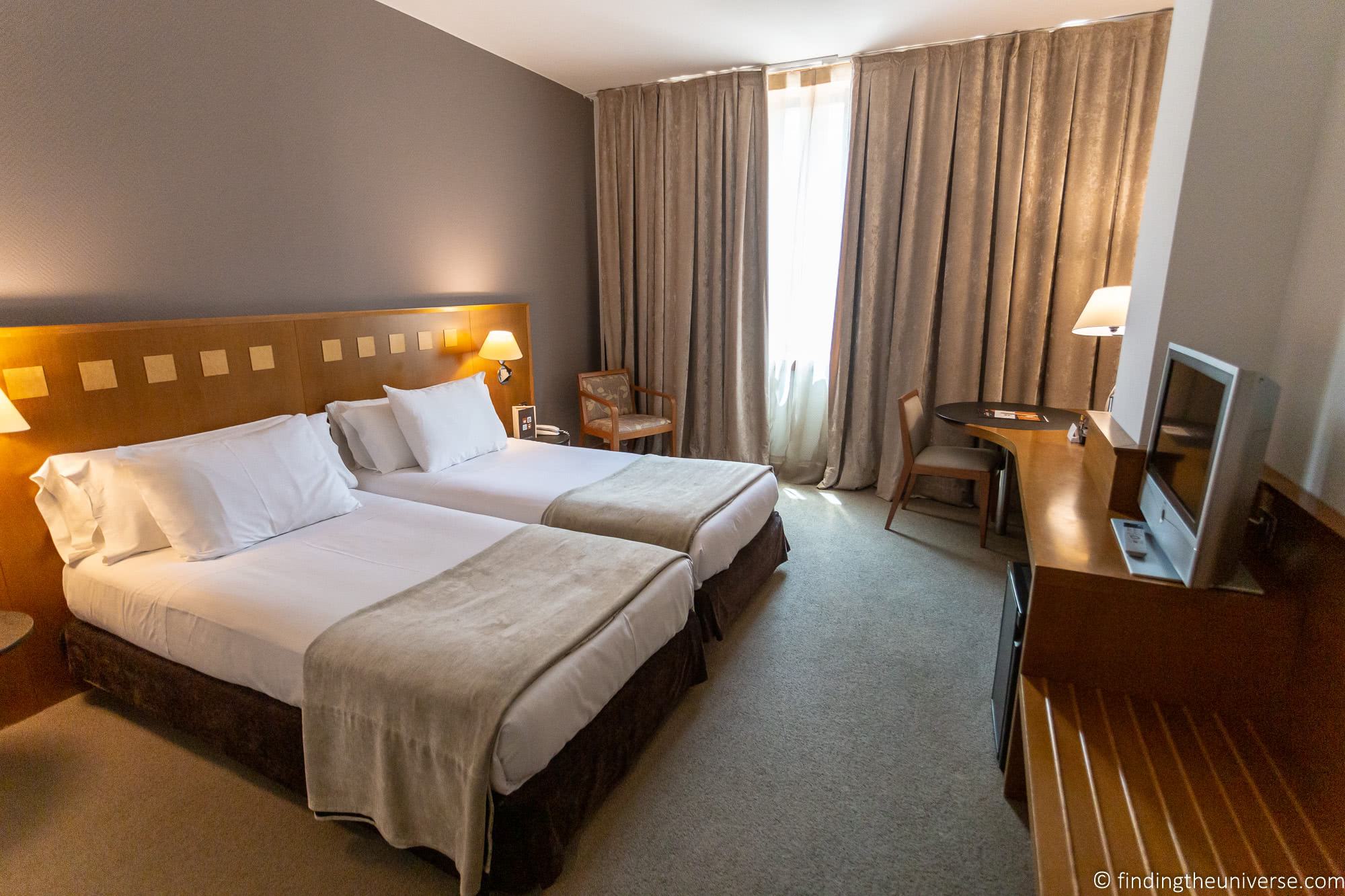
How to Get Around Barcelona
Barcelona is easy to get around, with an extensive bus, metro and light rail network. It’s also easily walkable for the most part, although you will likely want to take public transport for some of the slightly further out destinations such as Parc Guell, Tibidabo, and Camp Nou.
Alternatively, you can visit these locations on the hop on hop off bus, as outlined in our itinerary. More on that shortly.
If you are going to use public transport you have two options, depending on how much you want to travel.
First, you can buy individual tickets as you go. If you decide to do this, the most cost-effective way to do so is the ten ticket (T-Casual) card. This is much cheaper than buying individual tickets and also lets you change transport options within an hour and fifteen minutes of starting your journey.
The other option for public transport is the Hola BCN card, which gives unlimited access to the transport network in the city, and is available for durations from 48 hours to 120 hours. You can buy that online here.
There are a couple of other options for paying for your Barcelona transport.
First, if you purchase a Barcelona Card or a Barcelona Card Express, you get free travel on the metro, buses, trams and trains for the duration of the card. This includes the airport metro and train. These cards also include some discounts and attractions.
Second, if you purchase a Go Barcelona Pass or Barcelona City Pass, these both come with one day access to the Hop On Hop Off Barcelona Bus Tour, which covers nearly every major tourist site in the city.
Alternatively, you can purchase 1 or 2 day hop on hop off bus tickets directly here.
If you’re arriving into Barcelona by air, you can take a taxi or train into the city centre. There’s also an airport bus service, which is what we normally use. You can buy tickets on the day, but we normally reserve ours in advance so as not to have to worry about it. You can buy tickets for the Barcelona Aerobus here.
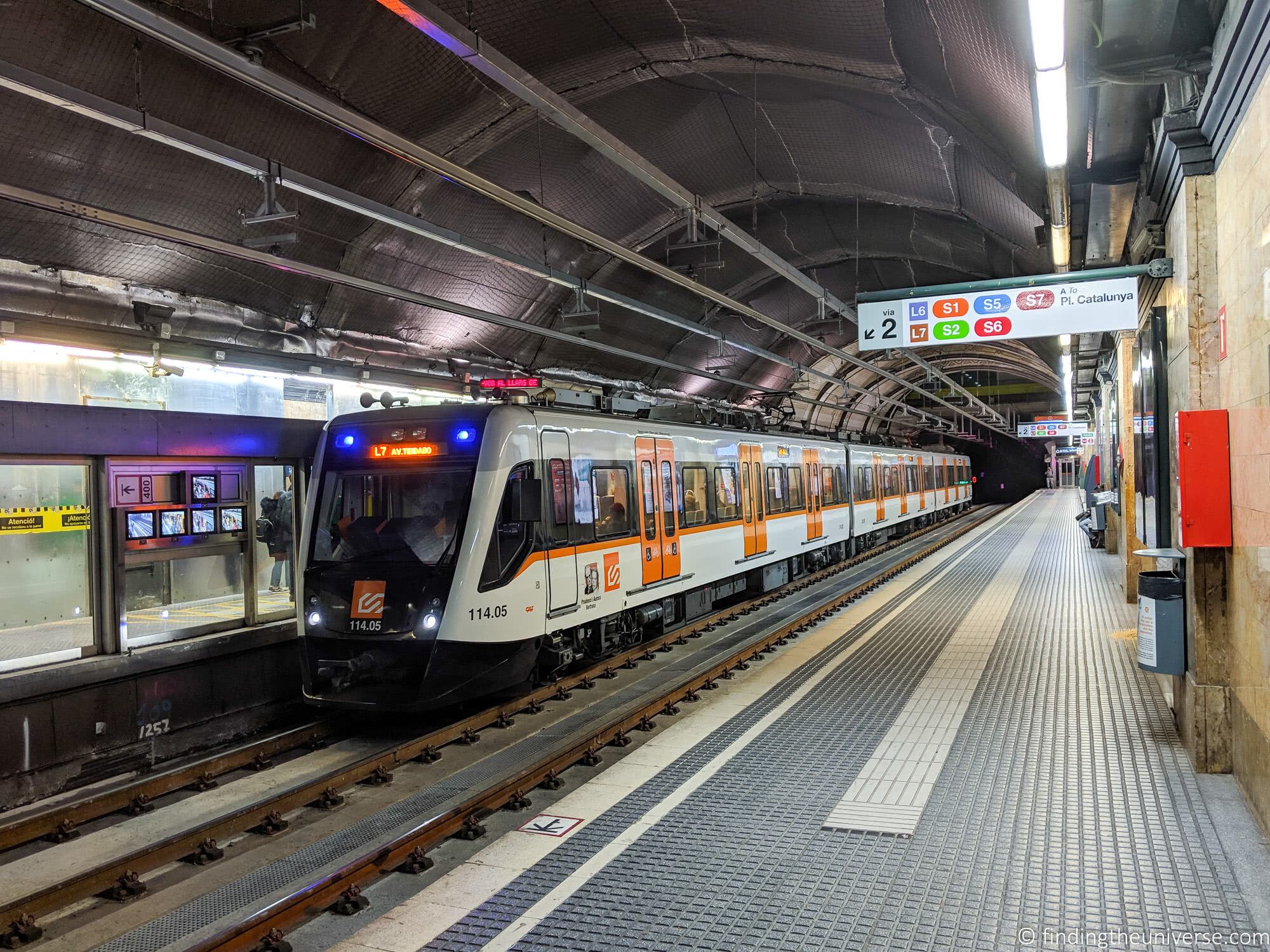
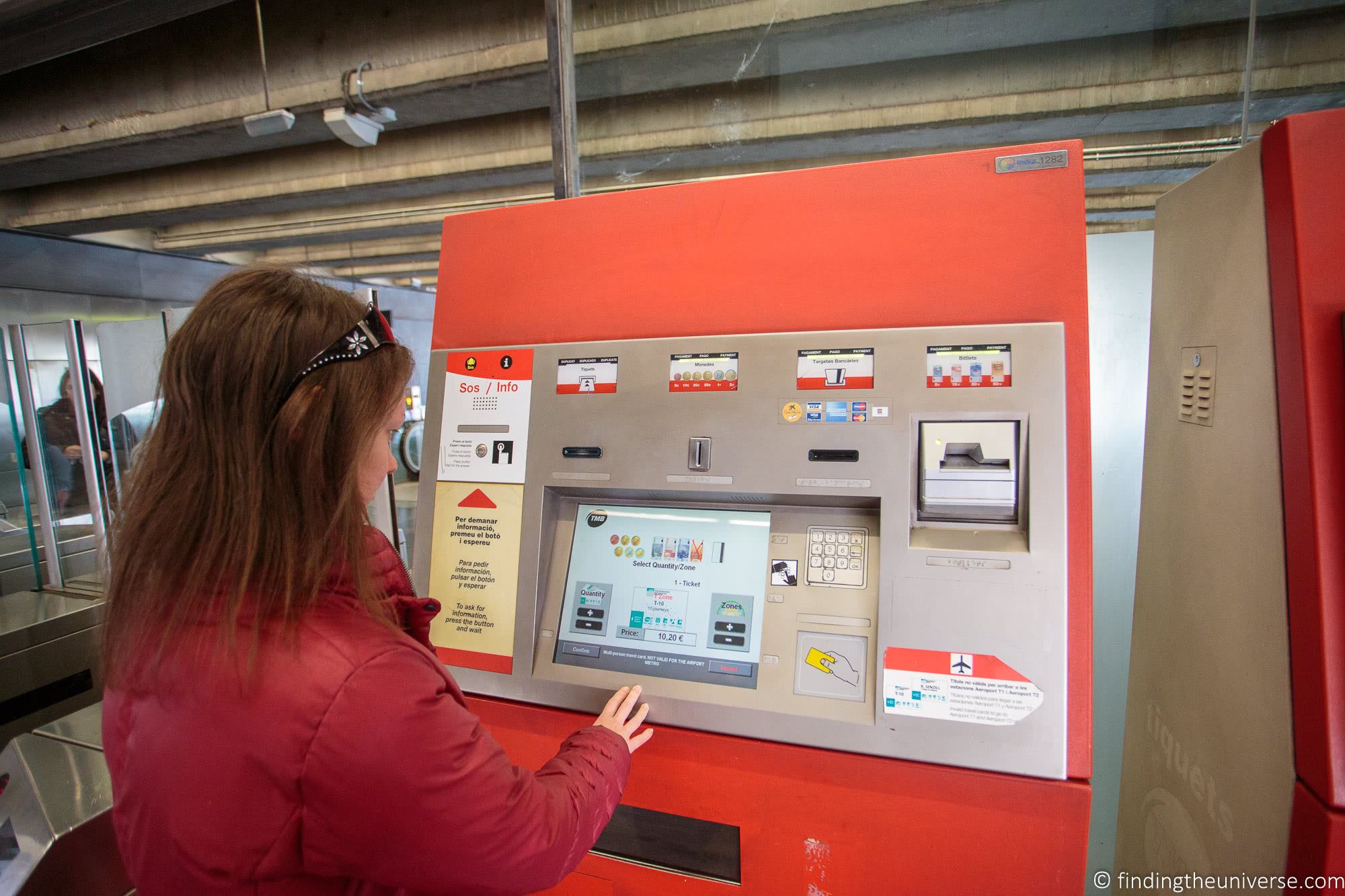
Suggested Walking Tours in Barcelona
We love taking walking tours when we visit a city. It’s a great way to learn a lot about its history, culture and people, as well as get tips on what to see and where to eat.
There are a number of walking tour companies offering tours in the city. If you pick up one of the aforementioned passes, some of these include a walking tour, so definitely take advantage of that.
Otherwise, we usually recommend walking tour company Take Walks. We’ve taken tours with them in cities around the world, and enjoy the small groups and knowledgeable guides. They offer a number of tours in Barcelona, some of which we’ve included below along with other suggestions.
Obviously, if you decide to take a walking tour you will need to tailor this itinerary to suit.
Naturally, there are also many other walking tours to choose from. See this selection on GetYourGuide and these options on Viator for more ideas.
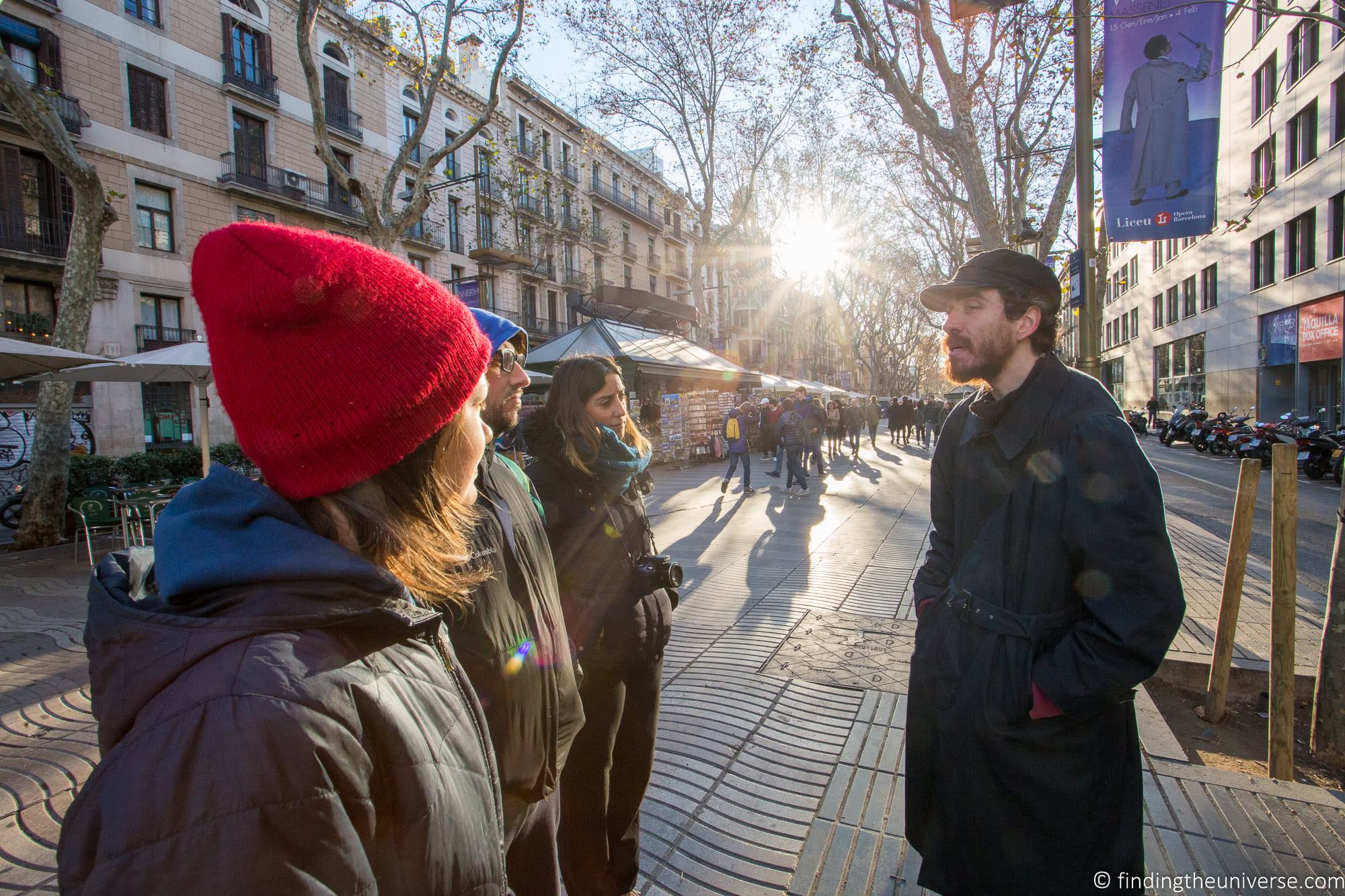
Saving Money with Barcelona Attraction Passes
One of the main costs when traveling is the price of entry to attractions. Obviously, if you have traveled a long way to visit Barcelona, you are going to want to see some sights and go inside them. However, you don’t want to spend more than you have to when doing that.
Like many cities around the world, Barcelona has a number of different attraction passes that can save you money on your sight-seeing. Barcelona has quite a few to choose from which offer different things, and we’ve actually put a post together comparing the main Barcelona attraction passes. We also have a full review of the Go Barcelona Pass.
Which pass will work for you will depend on which sights you really want to see. First, let’s look at the total cost. Assuming you visit all the attractions on our itinerary, choosing Camp Nou instead of Tibidabo, and using the Hop on Hop off bus for one of those days, you would be looking at paying around €200 per person.
Our recommendation, if you plan on visiting the majority of the attractions we list, would be the Go Barcelona Pass. This currently costs €104 per person (as of May 2022), and includes the following from our itinerary:
- Sagrada Familia with guided tour
- Parc Guell with guided tour
- 1 day Hop on Hop off bus pass
- Casa Batllo
- La Pedrera
- Camp Nou Tour
- Recinte Modernista de Sant Pau
- Montjuic Cable Car
- Gothic Quarter Walking Tour
It also includes a great many more attractions across the city, including walking tours, museum entry and much more. You can see all the attractions it includes here. We’ve used this card on multiple visits to the city and it has always saved us money.
We also like that it includes a guided tour of both Parc Guell and the Sagrada Familia, which is an additional value. The only thing to be aware of is that these tours run at specific times, so you will need to plan your itinerary accordingly.
Whilst we think this card offers excellent value for most visitors to Barcelona, we appreciate that not everyone will want to include everything. In this case, the other cards we suggest are:
- The Barcelona Card. This is offered by the city tourism office and includes free entry to some museums, free public transport, and a range of discounts on popular attractions
- The Barcelona City Pass. This includes entry to the Sagrada Familia and Parc Guell, access to the Hop on Hop off bus, a couple of audio guides and 10% discount on additional attractions in the city.
Again, for most visitors we feel that the Go Barcelona Pass offers the best cost savings and the most inclusions, but you should definitely check the savings and inclusions against your itinerary to be sure it works for you. You can buy yours in advance of your visit here.
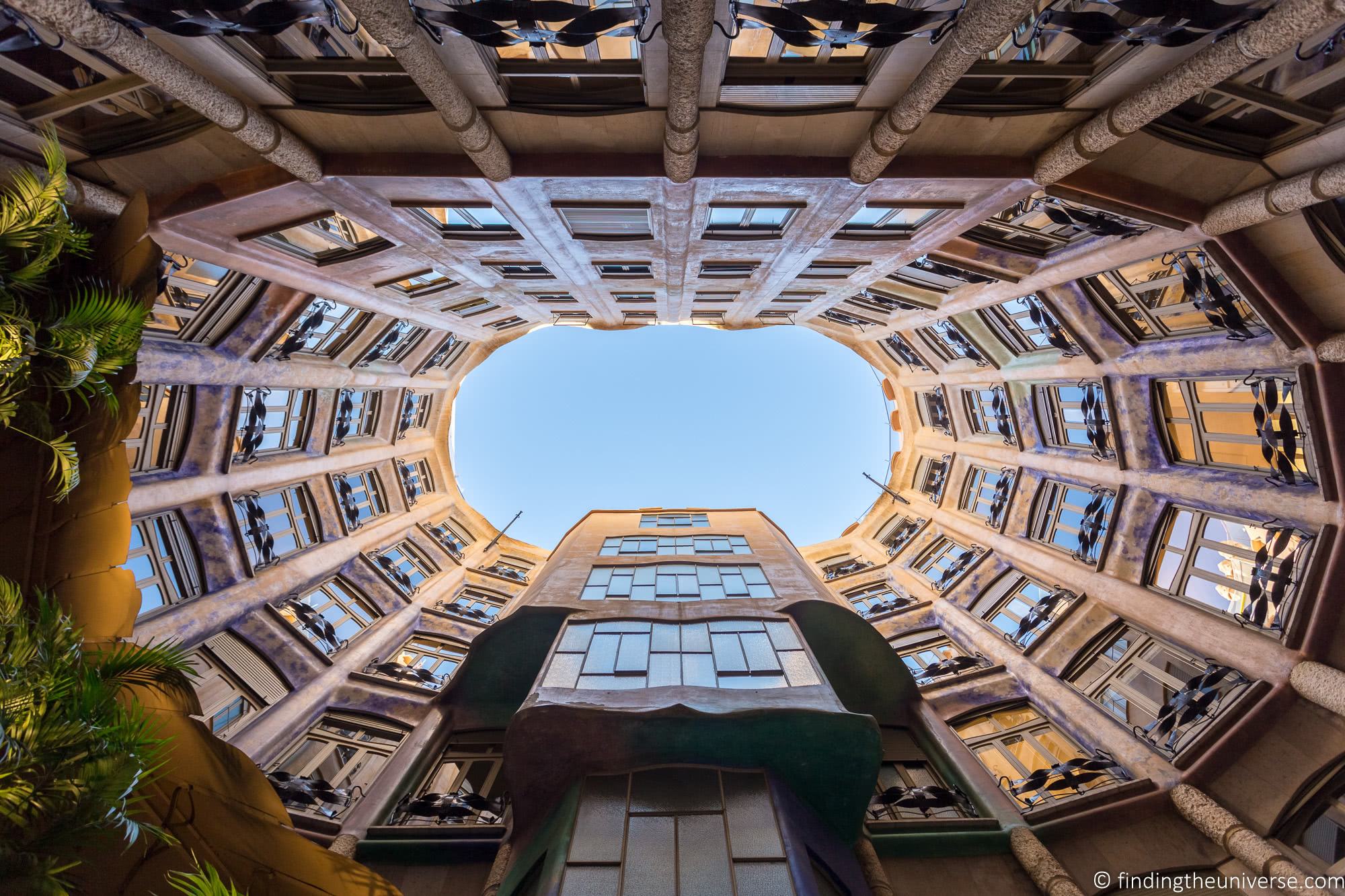
Further Reading
Well, that’s the end of our guide to spending two days in Barcelona! Hopefully you find it useful. As well as the above, we have a number of other resources we’d like to recommend to help you out, both content we’ve written ourselves, and resources we’ve found online. Between this post and these resources, you should be able to put together the perfect trip!
And that sums up our idea of how to spend the perfect two days exploring Barcelona! We hope you found this itinerary useful. Are you planning a trip to Barcelona? What do you want to see when you do? Let us know in the comments below!
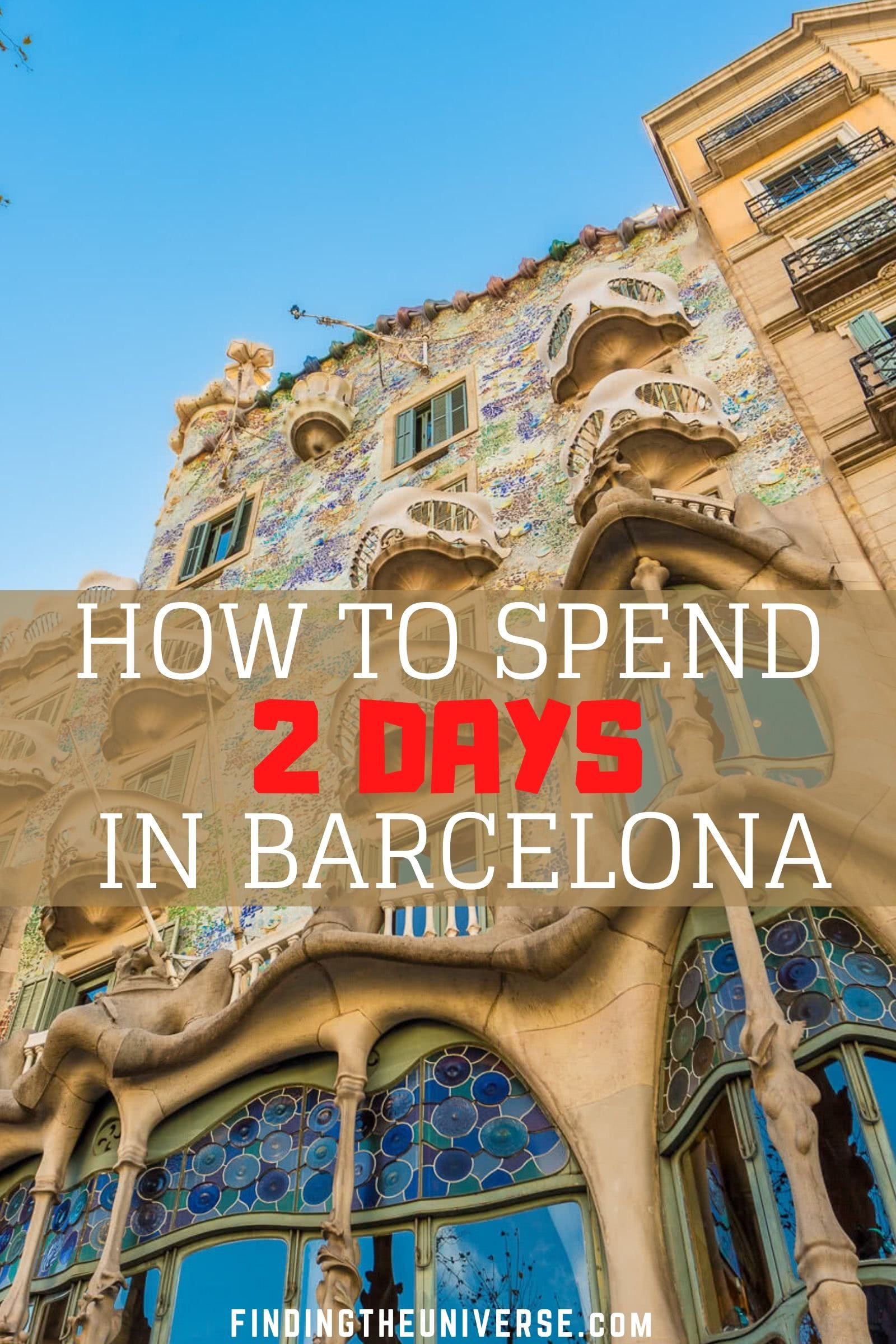





More Stories
Keeping Your Camping Food Hot – Top 5 Tips To Keep It Nice And Warm
3 Useful Tips For Camping With Seniors
Dubai Car Rentals – 4 Reasons Renting a Vehicle Is Worth It